Author’s Note: The Norwegian fjords is one of my favorite destinations to cruise to from the U.K., my home base. My first trip to the fjords was in 2016 and I’ve been back a handful of times since, kayaking, hiking, and exploring Norse history and cuisine.
Fjords in Norway are truly magnificent. Carved by glaciers during the last ice age, these picturesque inlets of water are found the length of Norway’s frilly western coastline. Deep and calm, they are sheltered from the open water, surrounded by thick green forests, and dotted with fishing villages and waterfalls.
From the Aurlandsfjord to the winding Sognefjord, fjords in Norway all have one thing in common—their cinematic scenery provides one giant dopamine hit for all who visit. From the best time to explore and what you might see, to how to get around, here’s everything to know about fjords in Norway.
What Is A Fjord?
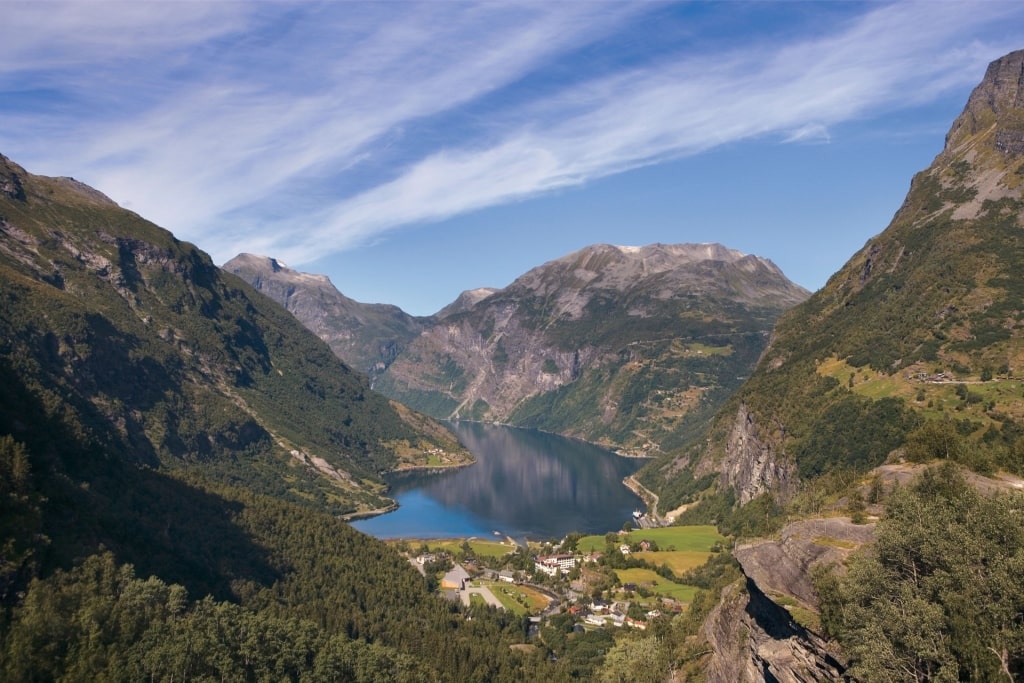
Geirangerfjord
A fjord is defined as a narrow, U-shaped inlet of water created by glaciers that carved deep valleys into the landscape thousands of years ago. When the ice retreated, the valleys flooded with seawater.
Fjords typically have steep sides, featuring vertical cliffs with waterfalls, snow-capped mountains, and pine forests. Such is the beauty of Norway’s fjords, they were inscribed on UNESCO’s World Heritage List in 2005.
Though most famously associated with Norway, fjords are also found in other destinations around the world, including Alaska, New Zealand, and Chile. Norway, however, is home to most of the world’s fjords, with around 1,700, including some that are so big they have smaller arms that branch off the main fjord.
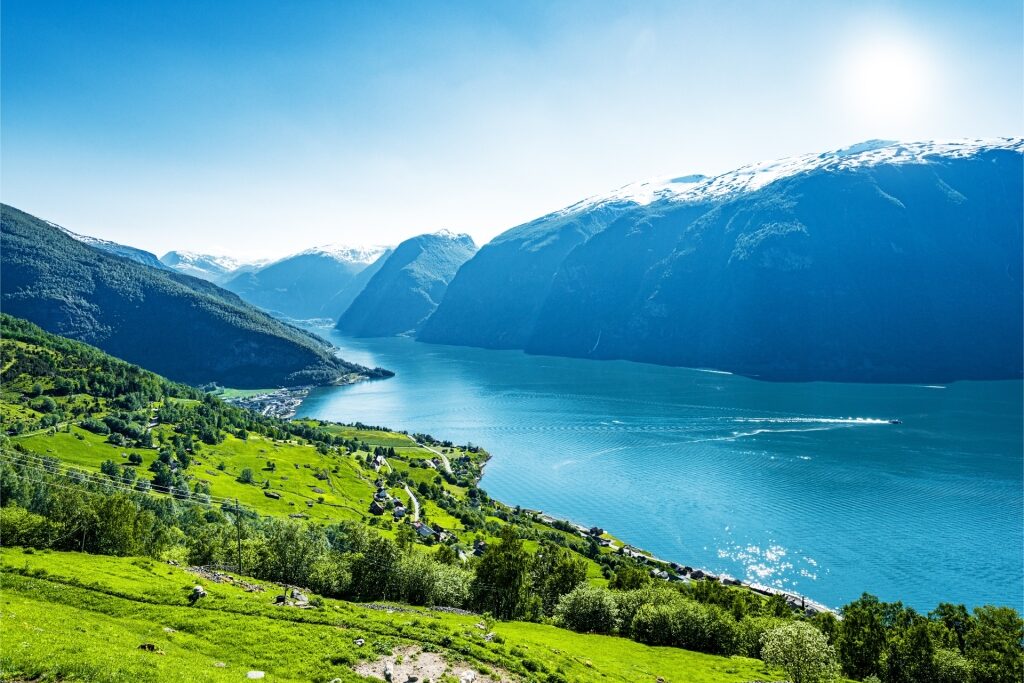
Sognefjord
One such is the 126-mile Sognefjord, which holds bragging rights to being the longest, deepest fjord in the world, close to the highest mountain in Northern Europe, Galdhøpiggen. The Sognefjord’s mouth lies a short distance north of Bergen in southwest Norway and its innermost point is the quaint village of Skjolden, with several smaller branches including Nærøyfjord and Aurlandsfjord.
At its deepest point, the Sognefjord is over 4,000 feet, roughly the same height as the soaring Mount Vesuvius in Italy.
Other famous fjords in Norway include the 111-mile Hardangerfjord, also close to the mountain city of Bergen, and the 68-mile Storfjord. Fjords in Norway are also home to coral reefs, including in the Trondheimsfjord, the third biggest fjord in Norway, at a depth of 128 feet.
History of the Fjords
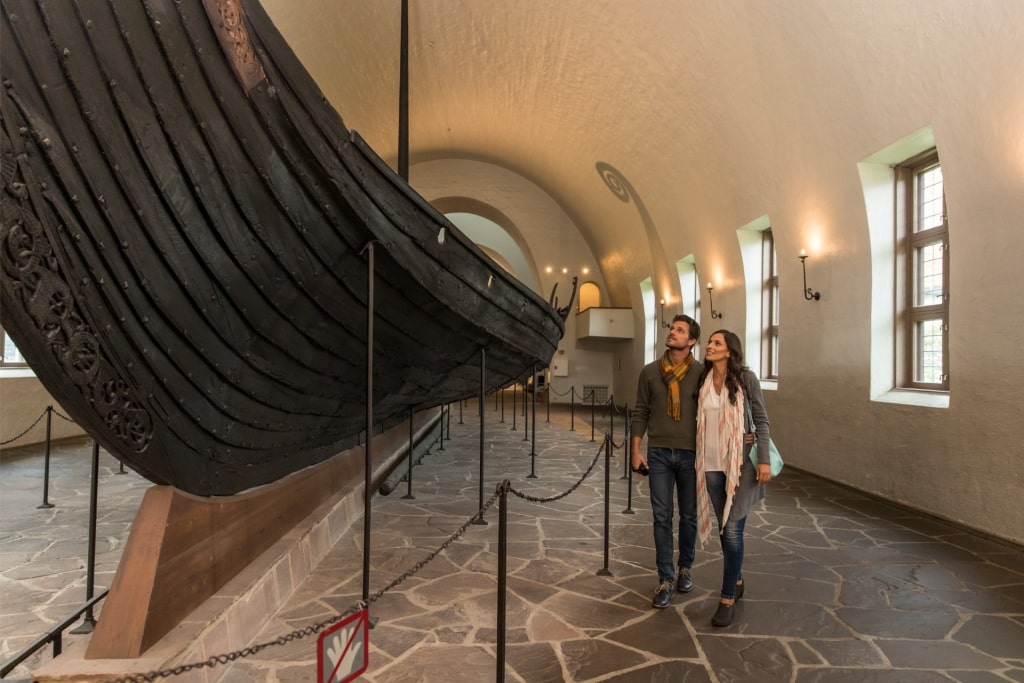
Viking ship
History buffs love exploring Norway’s fjords to gain a fascinating insight into the Viking Age, which spanned from roughly the 700s to 1100. Vikings originated in Scandinavia, including Norway, Denmark, and Sweden, with Viking settlements scattered around Norway’s fjords.
While Vikings were known as ruthless warriors, pillagers, and colonizers—arriving via Viking longships in Ireland, Iceland, North America, Greenland, and France—those that stayed home farmed and traded in this bucolic setting.
There are plenty of places to explore the Viking Age in Norway’s fjords, including at the Viking-Warrior Hamna Activity Centre in Nordfjordeid with its fun Viking and fjords-themed climbing wall. Close by, admire the replica 98-foot Myklebust ship, on Nordfjordeid’s waterfront, which also has a museum with virtual reality experiences.
Viking Planet in Oslo, on the Oslofjord, also uses virtual reality and 4D cinemas to bring the Vikings to life in an interactive 12-minute film. Stavanger has Viking House, which sees visitors don a VR headset to board a Viking ship and experience the Battle of Hafrsfjord. This was one of the most famous Viking battles that was fought close by, in the Hafrsfjord in 872, resulting in the unification of Norway.
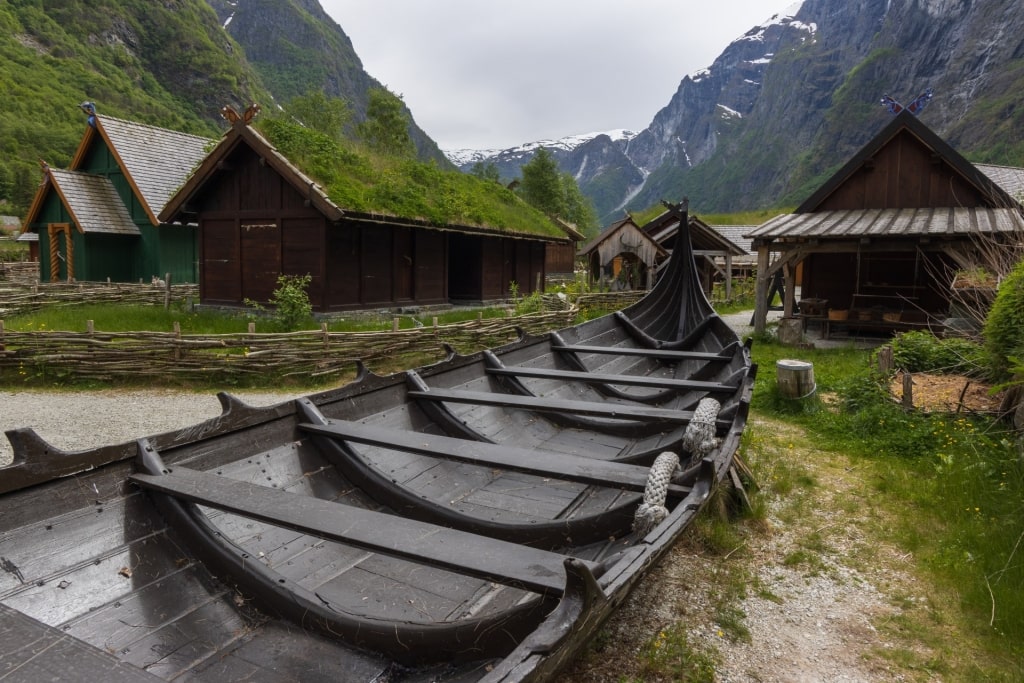
Njardarheimr
True-to-life Viking settlements include Njardarheimr Viking village in Gudvangen near Flåm. Njardarheimr is located at the innermost point of the Nærøyfjord, with Nærøyfjord dedicated to Njord, the Old Norse God of trading and sailing. Njardarheimr is home to real Vikings who have adopted the lifestyle as it was lived 1,000 years ago, when Gudvangen was founded.
It’s one of the best places to learn about how Vikings lived, worked, and cooked, with Norwegian food prepared around a camp using traditional methods and tours offered of the fjord-side village.
What to Expect When Visiting the Fjords
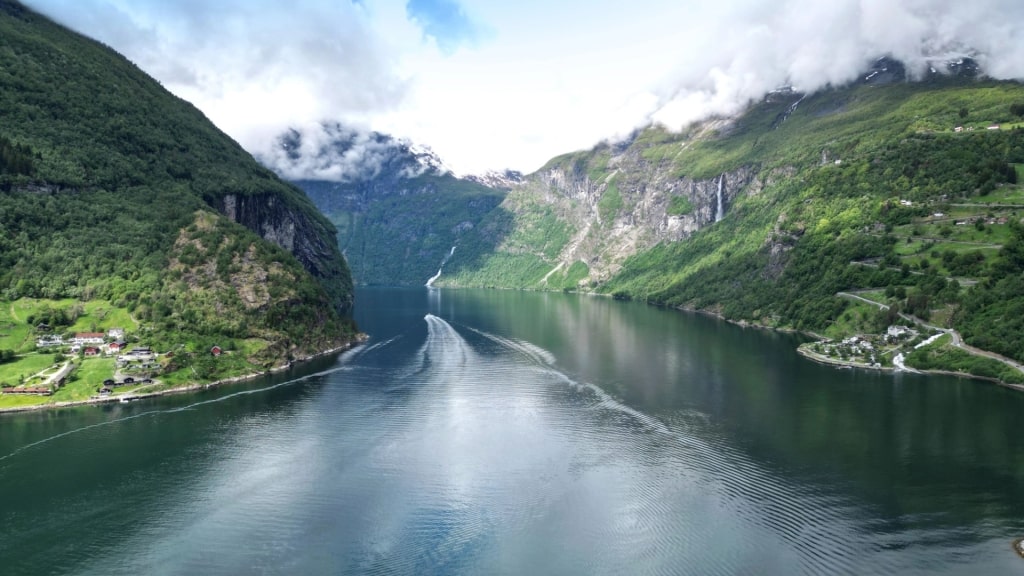
Geirangerfjord
The number one thing to expect when visiting fjords in Norway is to be stopped in your tracks by how beautiful they are. The water is usually cold, still, and reflects the surrounding landscape of pine trees and snowy mountains.
A visit to the Norwegian fjords is relaxing and exhilarating, where you can balance leisurely walks and admiring the spectacular scenery with thrilling activities, such as hiking mountains and kayaking on the fjords.
Expect to see goats grazing on wild pastures, waterfalls trickling down mountainsides, and pretty towns and villages, such as Olden and Trondheim that are home to colorful traditional timber houses and cozy coffee shops.
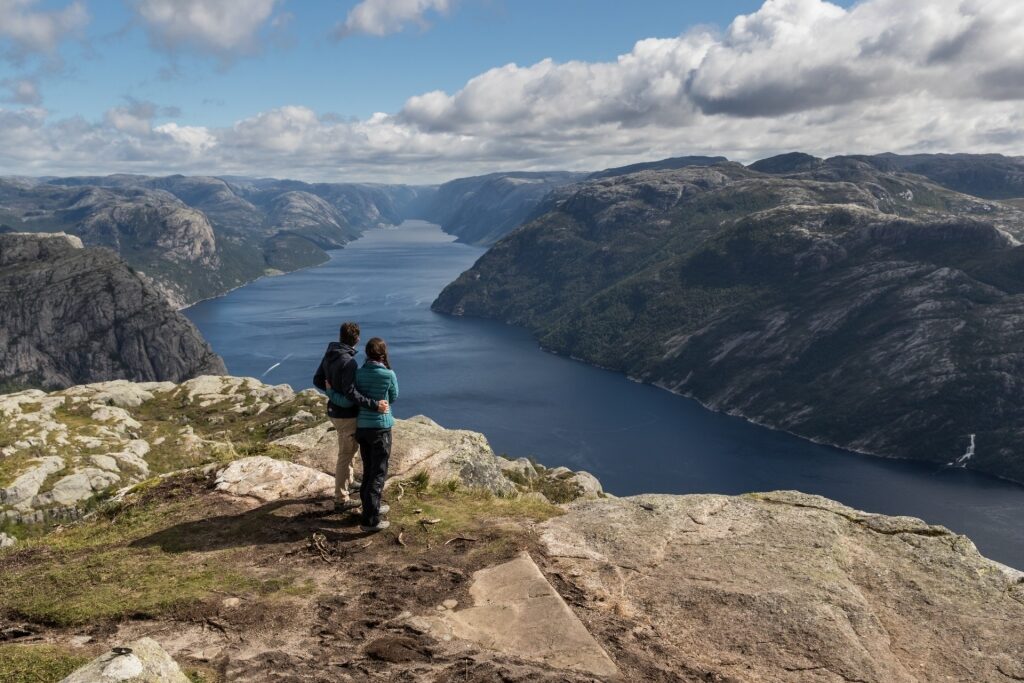
Pulpit Rock
Famous fjords in Norway include the Geirangerfjord, Lysefjord, Hardangerfjord, Sognefjord, and Hjørundfjord and they all offer breathtaking sights. Lysefjord is home to Pulpit Rock, also known as Preikestolen; Geirangerfjord has the Seven Sisters waterfalls, and Hardangerfjord has the summer ski resort of Fonna.
What else can you expect in Norway’s fjords? You should expect the unpredictable when it comes to the weather. Be prepared, with layers and waterproofs.
Getting Around: How to Explore the Fjords
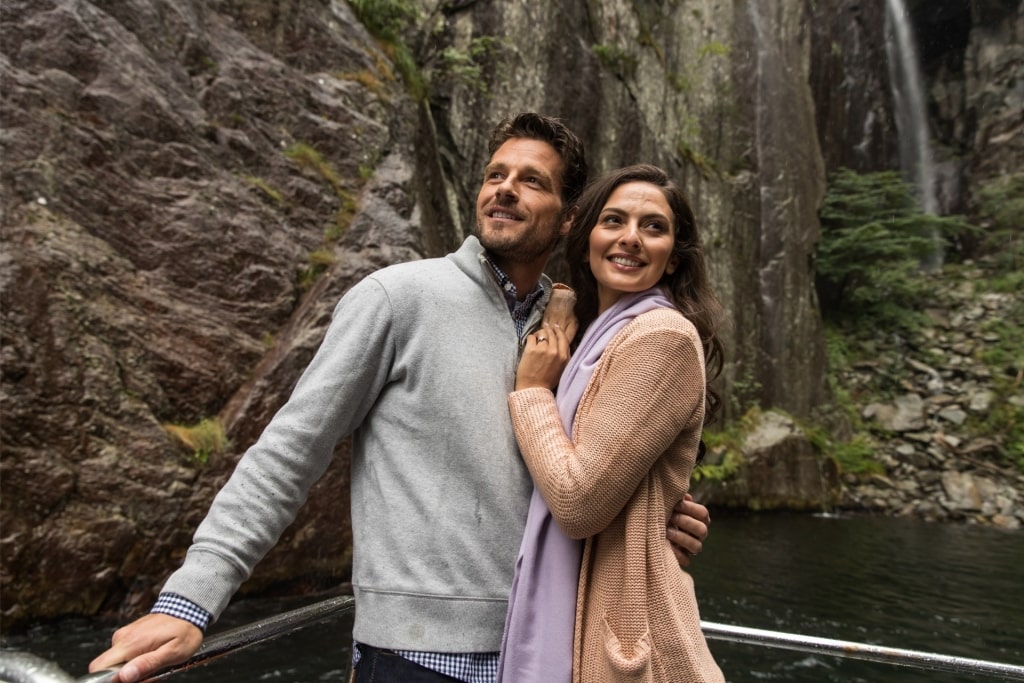
Lysefjord
Norway has a fantastic public transport system with trains, buses, and ferries operating in major cities and towns across the fjord region.
One of the best ways of getting around cities such as Stavanger, Bergen, and Oslo is via bus, with the capital also offering an underground metro service, called the T-banen.
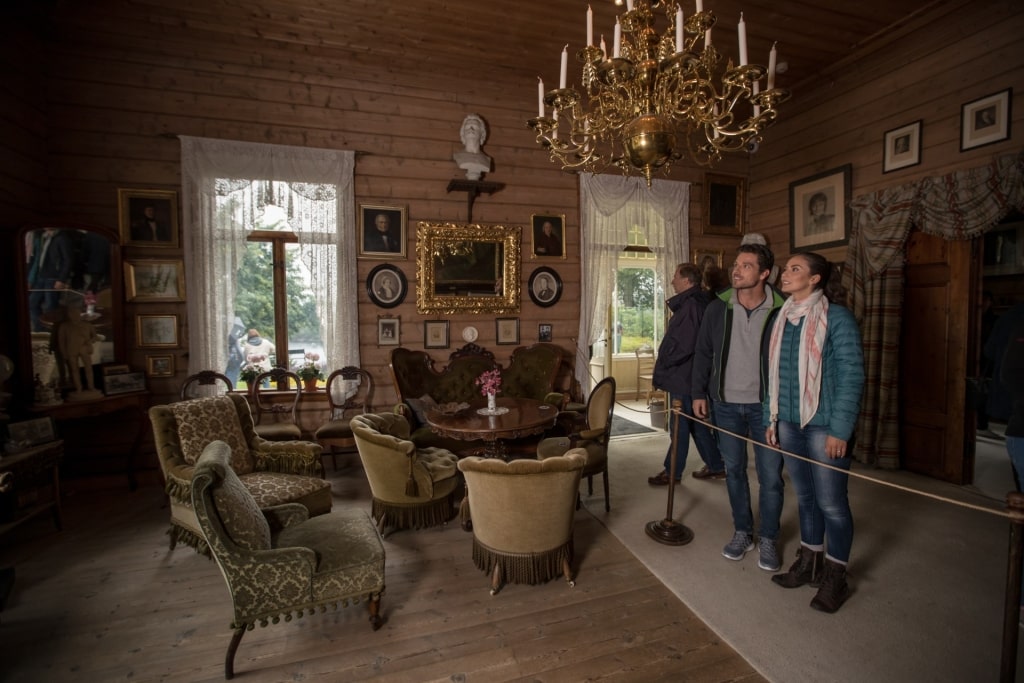
Troldhaugen
Bergen has Skyss, a light railway system that also links the city with the wider county Vestland, including stops at Troldhaugen museum, the former home of Norwegian composer Edvard Grieg.
Getting around by ferry and boat is common, with services operating around Norway’s fjords, including connections from Geiranger to Hellesylt on the Sunnylvsfjorden and from Molde to Sekken on the Romsdalsfjord.
Best Fjords in Norway
Geirangerfjord
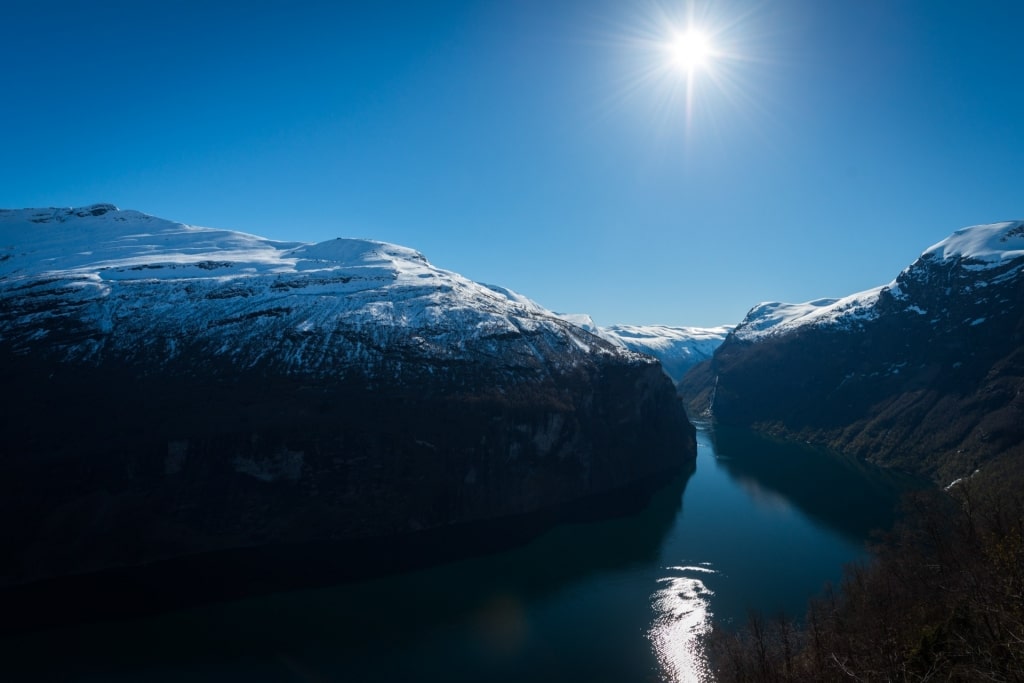
Geirangerfjord
One of the most beautiful places in Norway, the UNESCO-listed Geirangerfjord spans nine and a half miles at the innermost point of the Storfjorden, with the hamlet of Geiranger at the fjord’s tip.
There’s a kayak center in the village for guided tours of the glassy fjord. Few Norway fjords experiences compare to paddling in the water to the Geirangerfjord’s Seven Sisters waterfalls. Pack your camera in a waterproof case to capture the cascade tumbling 820 feet into the fjord.
Travelers could also experience a leisurely boat ride, a high-speed rigid inflatable boat (RIB) tour, or an exhilarating canoe trip.
Geirangerfjord is laced with hiking trails offering scenic views of the glistening fjord, including the Fosseråsa route. It’s signposted from the center of Geiranger to Storsæterfossen. The route takes up to two hours return, depending on your pace.
For some of the most incredible views of the snowy and pastoral landscapes around Geirangerfjord make your way to Geiranger Skywalk viewing point—almost 5,000 feet above the sea—at Dalsnibba. Opened in 2016, Geiranger Skywalk seemingly floats in the sky, high above the fjord.
Lysefjord
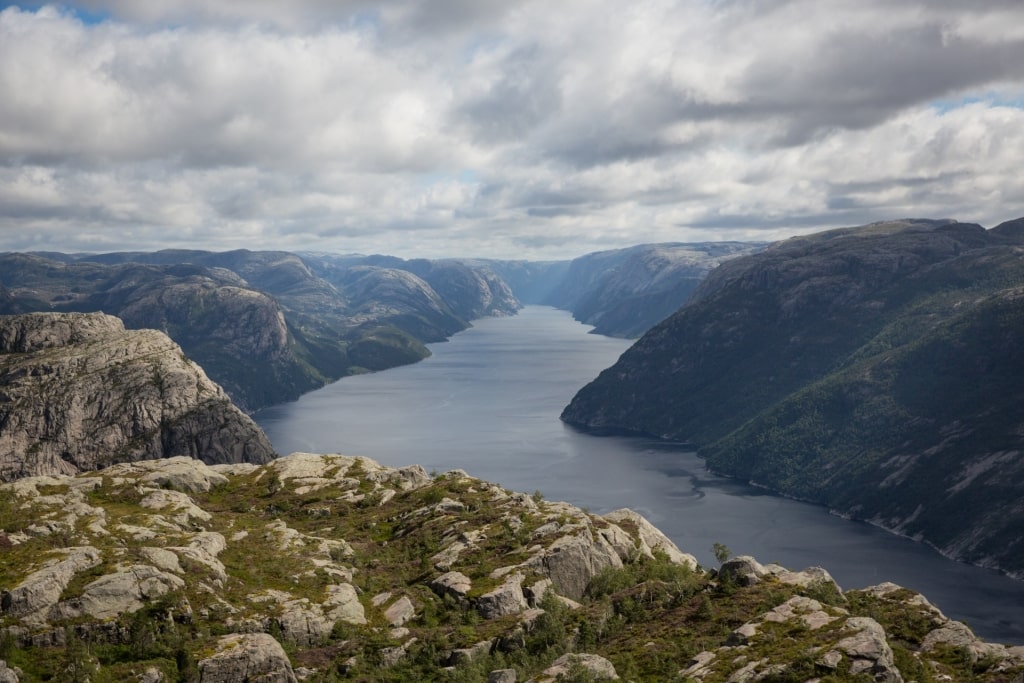
Lysefjord
One of the best things to do in Stavanger is to take a day trip to Lysefjord, famed as the home of Preikestolen, or Pulpit Rock, in Ryfylke.
Towering almost 2,000 feet above the sapphire-blue fjord, Preikestolen is a leaden-hued rock formation with a massive flat-top ledge. Travelers can reach the top to take in the far-reaching views on one of Norway’s most famous hikes.
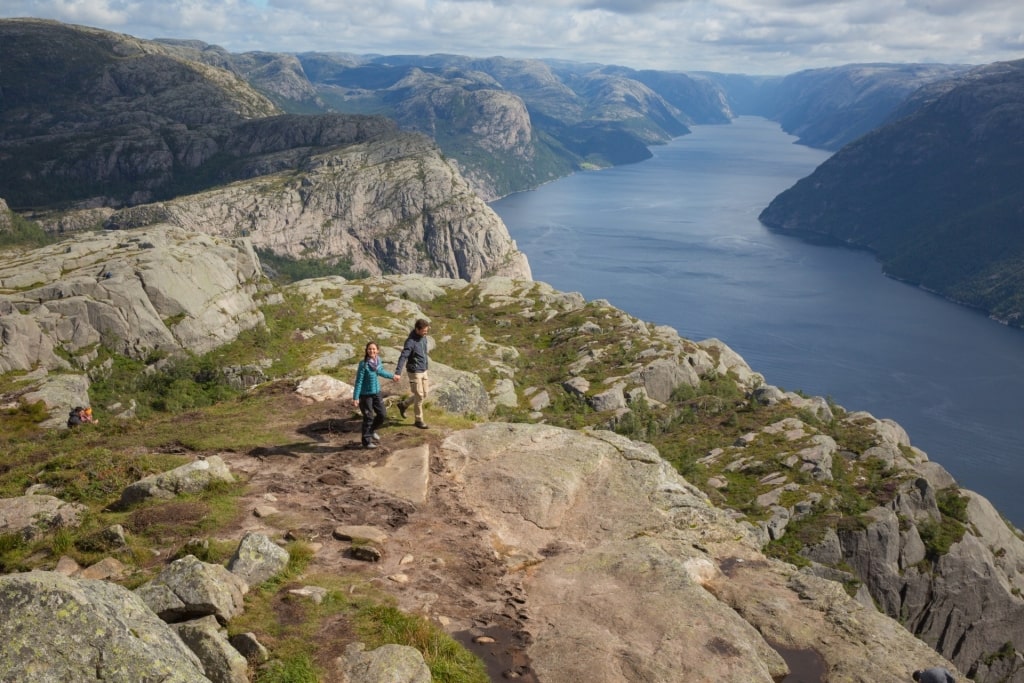
Pulpit Rock
The five-mile round trip starts at Preikestolen Fjellstue mountain lodge. It’s a demanding trek, but well worth it for the cinematic views that Norway is known for. As with any hike in Norway, wear suitable clothing and boots with a good grip.
The 26-mile Lysefjord can also be enjoyed via a fjord cruise from Stavanger, which takes around three and a half hours. This sedate trip offers the chance to see Preikestolen from the water and feel the spray of the fan-tailed Hengjanefossen waterfall.
Nærøyfjord
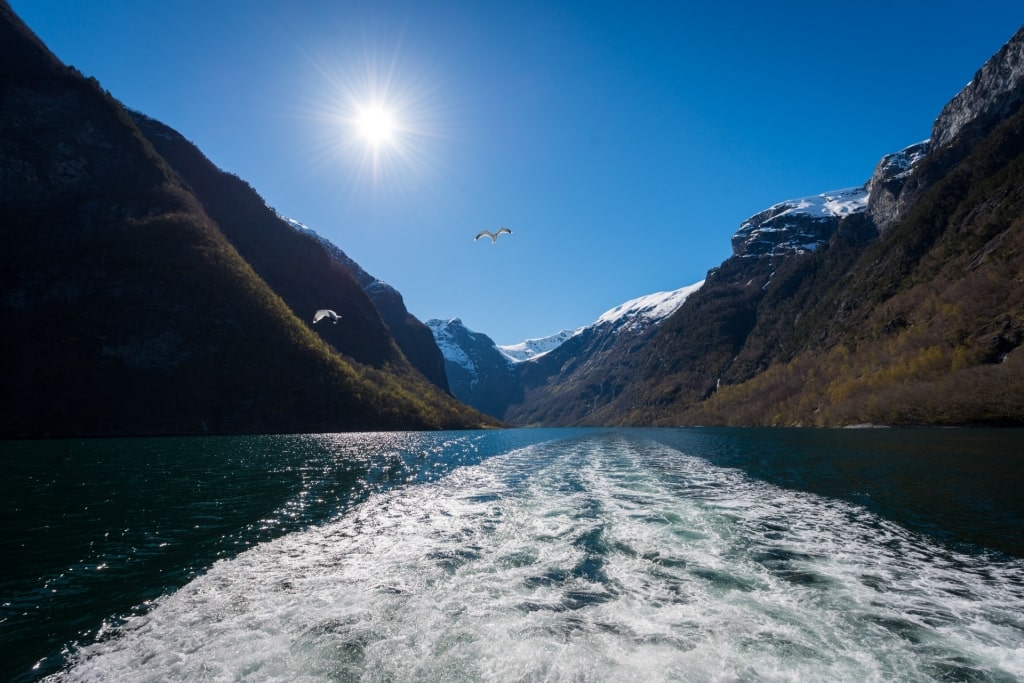
Nærøyfjord
Another UNESCO-listed Norway fjord, Nærøyfjord is a spectacular arm of the Sognefjord. At ten and a half miles long and just 820 feet at its narrowest point, Nærøyfjord is small in size but big on drama, and sailing along here is one of the best things to do in Norway.
Rousing green-covered mountains loom over Nærøyfjord, while the attractive village of Bakka and its good-looking white timber church sits on the fjord’s west shore.
The Nærøydalselva River empties into the fjord at Gudvangen, at the inner point of Nærøyfjord. Here, travelers can explore Njardarheimr, a Viking village that mirrors life 1,000 years ago.
Tour Viking long houses and boat houses, and gain a deeper sense of how Vikings traveled, lived, and worked during a 45-minute tour.
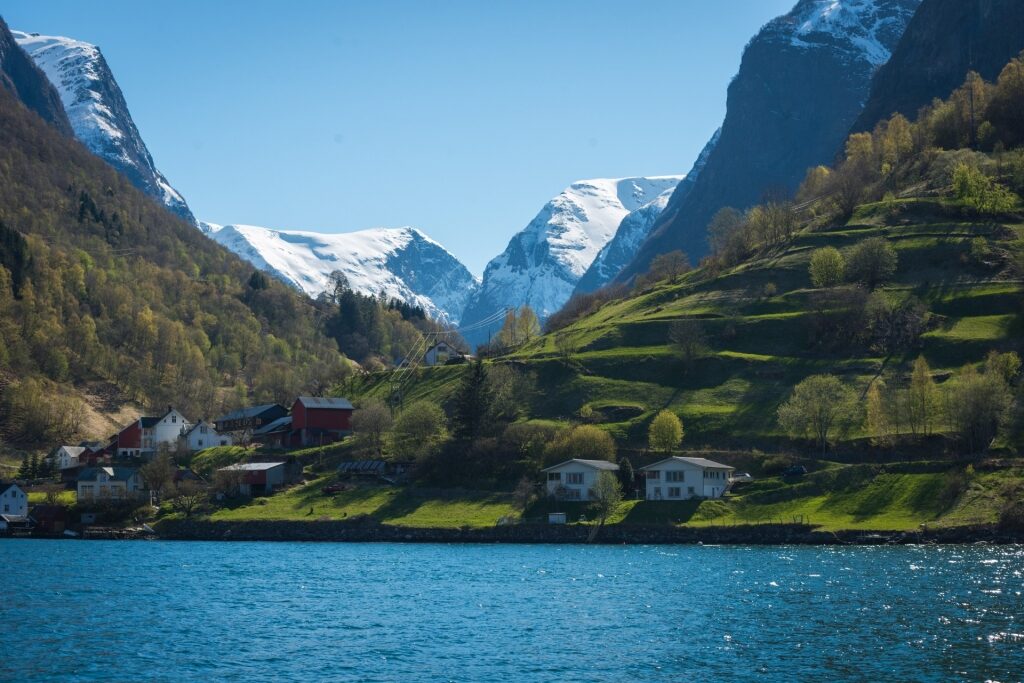
Flåm
If you’re more invested in soaking up the mountain scenery, there’s a boat service from Gudvangen to Flåm, or vice versa, on the parallel fjord, while the Rimstigen path offers a glorious hike through forests, past farms, and waterfalls.
Aurlandsfjord
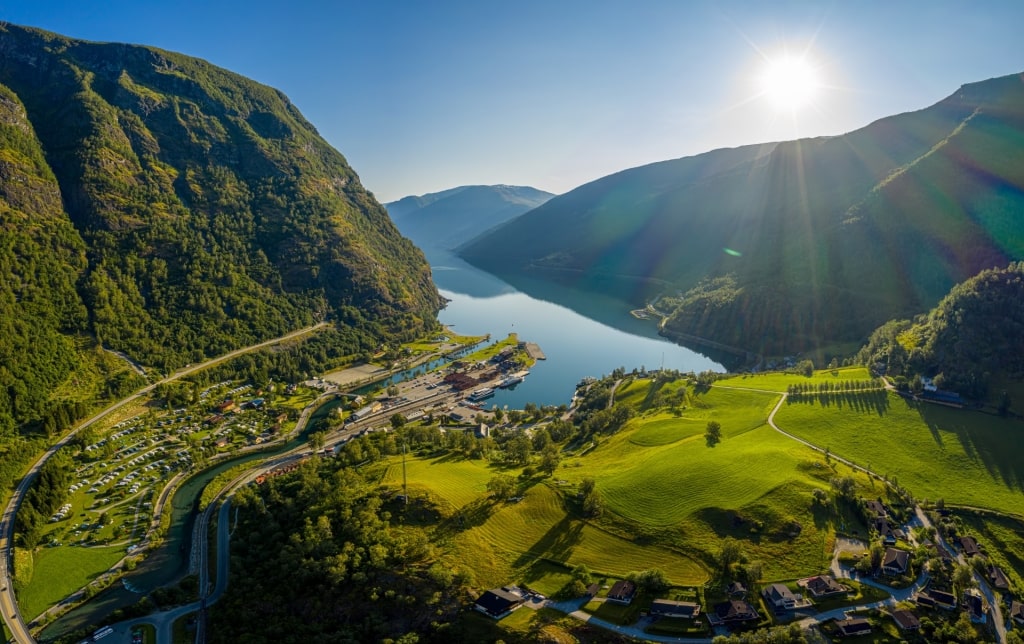
Aurlandsfjord
The Aurlandsfjord is as pretty as its neighbor, Nærøyfjord. Branching off Norway’s longest fjord, the Sognefjord, three villages lie on Aurlandsfjord: Undredal, Aurlandsvangen, and Flåm.
Travel to the Stegastein Viewpoint, reached via a zigzagging road from Aurlandsvangen, on the east side of the fjord. The road leads up the mountainside some 2,000 feet, with a viewing platform hovering among the green treetops.

Flåm Railway
A 10-minute drive south of Aurlandsvangen, Flåm lies at Aurlandsfjord’s innermost point. Here, the Flåm Railway traverses through the lush valley to reach Myrdal station, 2,844 feet above sea level.
A ride on the Flåm Railway is a two-hour round trip and is one of the most scenic railway journeys in the world. If you haven’t ridden it before, it’s a must-do.
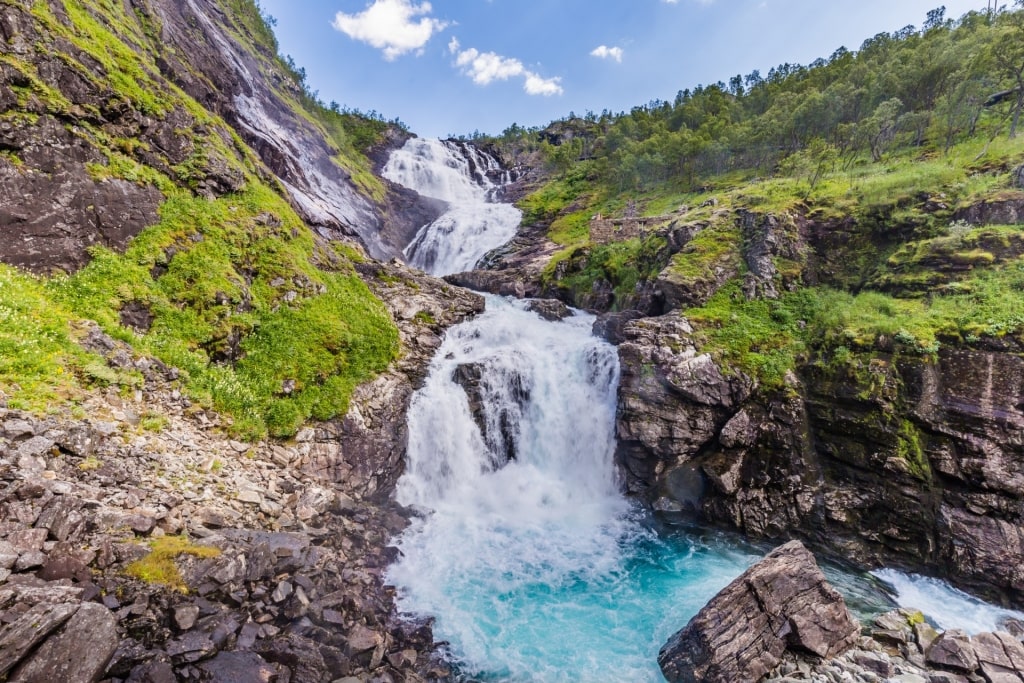
Kjosfossen Falls
The steep line travels through 20 tunnels, passes the handsome Flåm Church, and stops at the beautiful Kjosfossen Falls, where passengers can hop off. Enjoy the embrace of the waterfall’s fine mist, while stopping for a photo before stepping back inside the pine-green carriages.
Back in Flåm, explore the history of the prized railway at the Railway Museum. There’s a village bakery for fresh bakes and coffee, the fish market for warming seafood soup, and the cozy Ægir microbrewery for craft ales.
Innvikfjorden
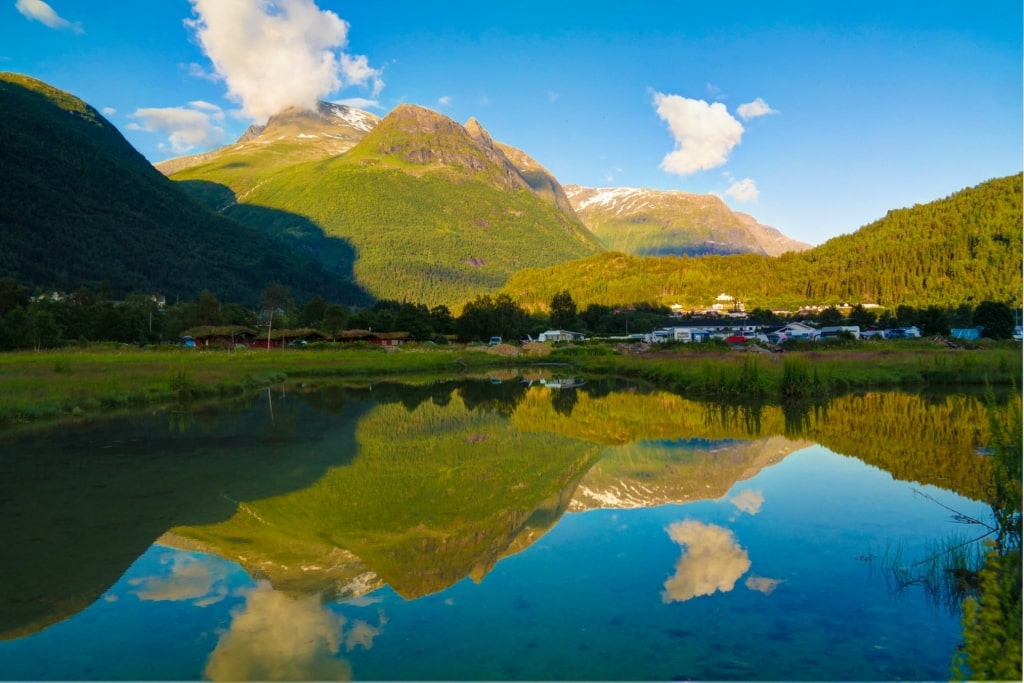
Innvikfjorden
The sweeping Innvikfjorden is another extraordinary Norway fjord, close to the mighty Jostedalsbreen National Park, mainland Europe’s largest glacier.
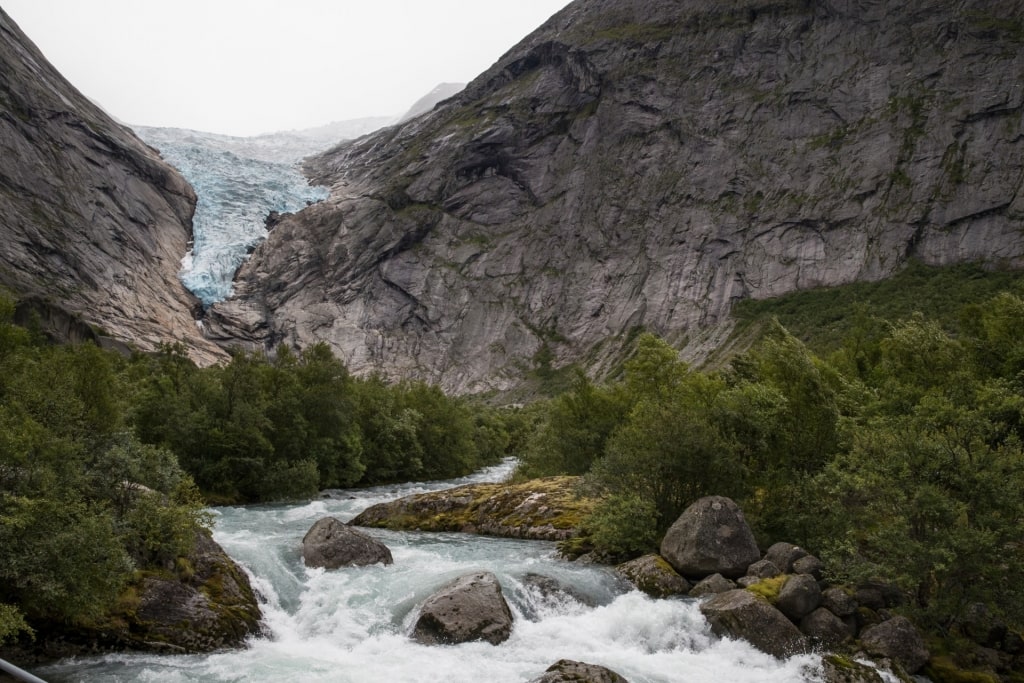
Briksdal Glacier
Intrepid travelers can venture to the ice-blue Briksdal Glacier, an arm of Jostedalsbreen that’s reached via a moderate-level hike through pine forests and by waterfalls.
The dazzling route covers around two miles and takes up to two hours on foot, roundtrip. There’s also a troll car, taking around 90 minutes roundtrip.
In Loen, a few miles north of Olden, opt to scale Mount Hoven via the Loen Skylift for a breathtaking ride toward the clouds. The cable car is one of the sharpest in the world, reaching a height of 3,317 feet.
At the summit, there’s a zipline that whizzes across the upper section of the Tungejølet gorge, high above the fjord.
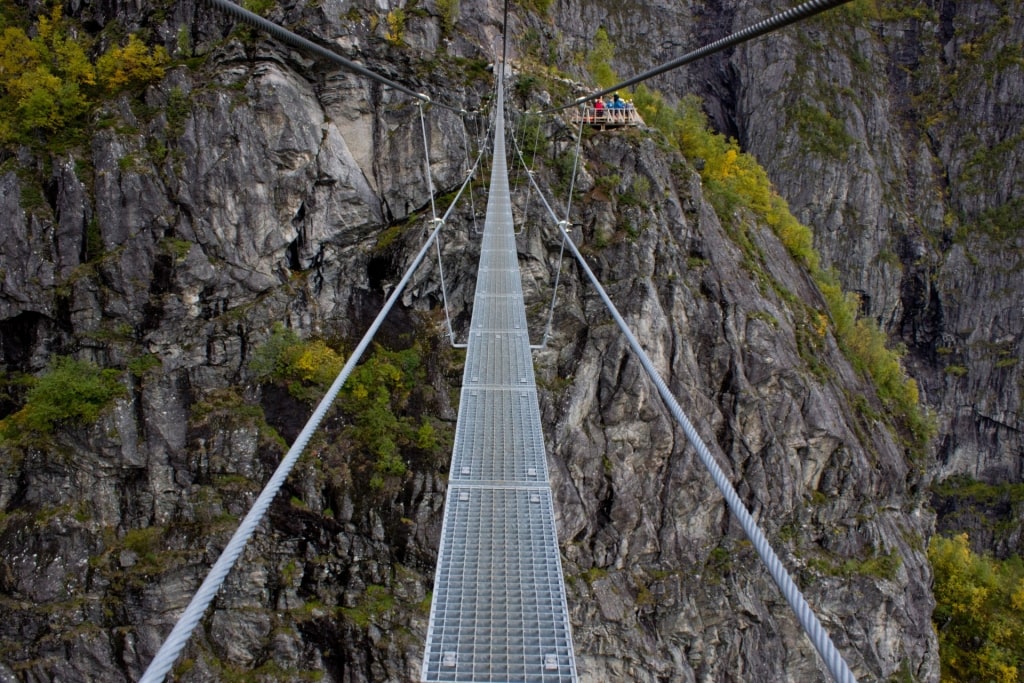
Via Ferrata Loen
More experienced hikers and climbers might want to tackle the Via Ferrata Loen. This difficult climbing route sees participants secured by a wire to cross the narrow Gjølmunnebrua, Europe’s longest via ferrata bridge, 2,460 feet above the sea.
The views of Innvikfjorden and the surrounding Norwegian mountains—Lodalen, Oldedalen, and Skåla—are magnificent.
A more relaxing way to enjoy the views is from Hoven Restaurant, next to Loen Skylift, where a charcuterie platter, venison stew, and a salmon or veggie burger are among the pleasing dishes.
Hardangerfjord
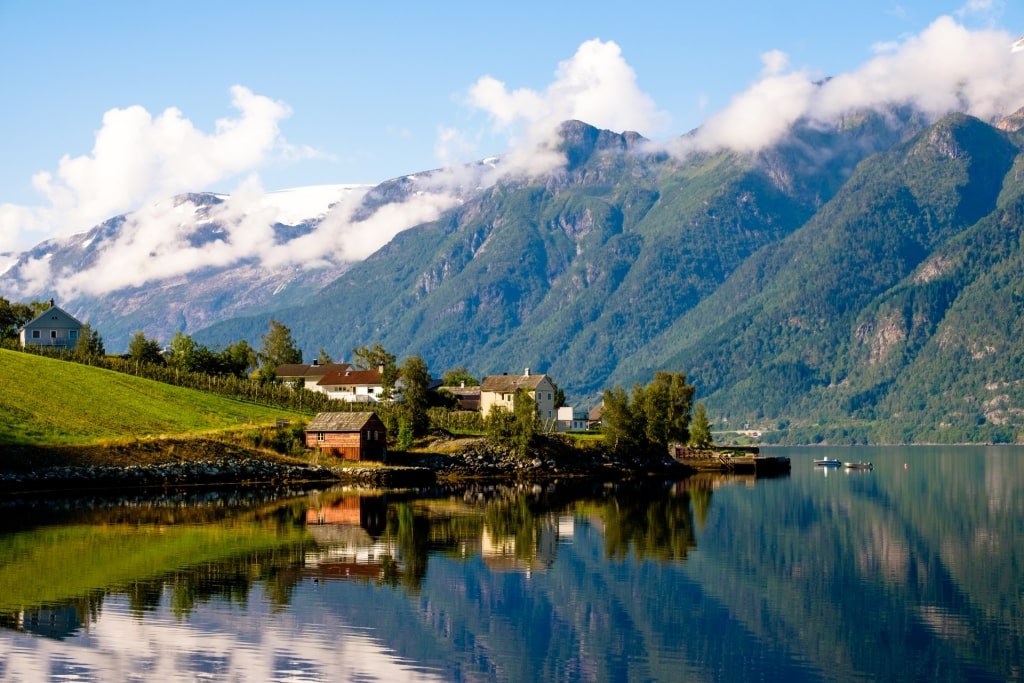
Hardangerfjord
Hardangerfjord is the second-largest fjord in Norway, spanning 111 miles, roughly a 90-minute drive south of Bergen, on the country’s serrated fjord coastline.
Norheimsund is a notable village on Hardangerfjord, with a pretty waterfront with a wide-open grassy promenade dotted with silver birch trees on the fjord’s north shore.
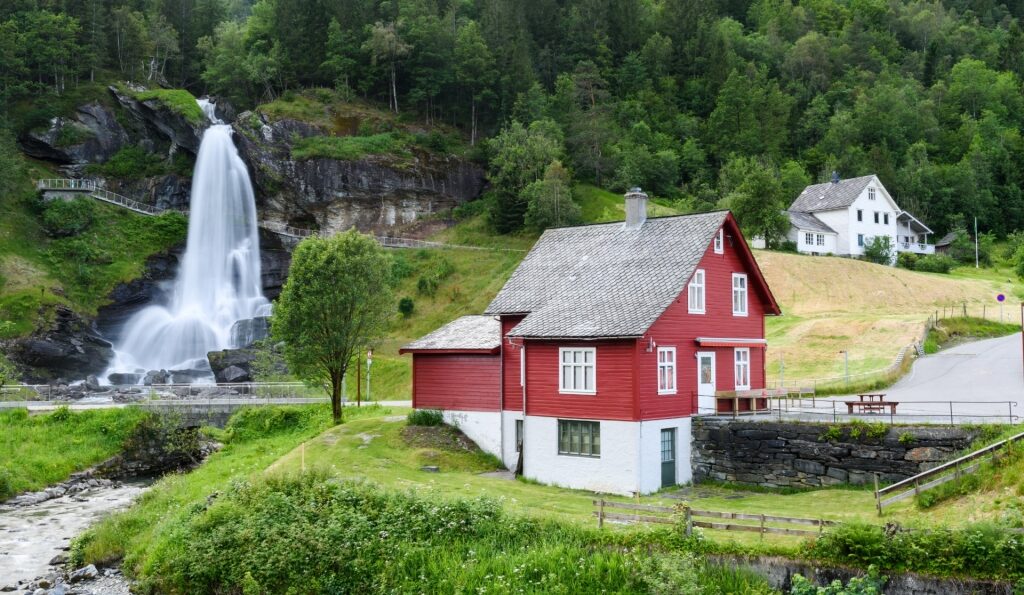
Steinsdalsfossen
Traditional clapboard buildings line the harbor, where the Hardanger Maritime Center is located. This fascinating maritime museum offers ropemaking and wooden-boat-building activities. After, tag on a visit to Steinsdalsfossen, a powerful waterfall on the Fosselva River where a foot trail leads behind the veil of water.
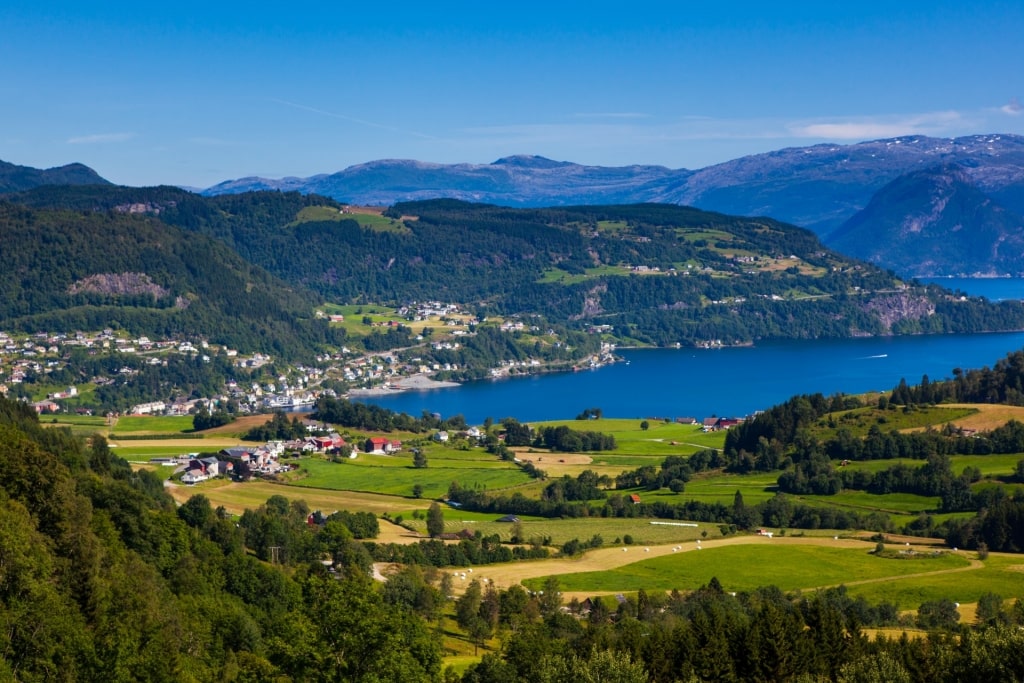
Hardanger
With marvelous apple orchards blooming around Hardangerfjord’s verdant slopes, apple juice and apple cider are among the popular local libations.
On the edge of the fjord, just outside of Norheimsund, stop by the idyllic Steinstø Fruit Farm, a ninth-generation producer of strawberries, raspberries, cherries, plums, apples, and pears.
There’s a restaurant and shop where visitors can pick up produce, including cider, jams, and jellies.
Nordfjord
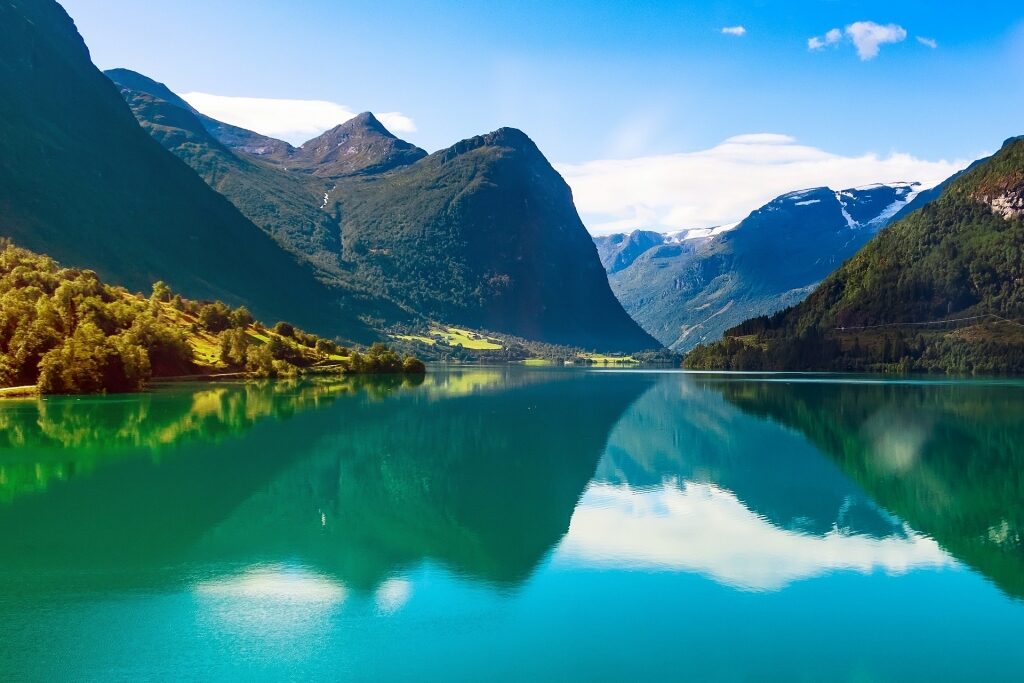
Nordfjord
The 66-mile Nordfjord is among the largest fjords in Norway. Featuring several smaller arms, Nordfjord weaves from the islands of Vågsøy, Bremangerlandet, and Husevågøy on the wild North Atlantic coast to Loen, on the Innvikfjorden.
Nordfjord lies near Hornindalsvatn—the deepest lake in Europe—which flows into the River Eidselva and empties into the Nordfjord at Nordfjordeid, a former Viking settlement and one of the larger towns on the Nordfjord.
Factor in a visit to Sagastad Viking Center. It’s the location of the extraordinary Myklebust, a 98-foot Viking ship, the largest ever discovered in Norway, found in 1874. Sagastad is a great place to learn more about Viking culture, with exhibitions, a cinema, and a virtual reality experience.
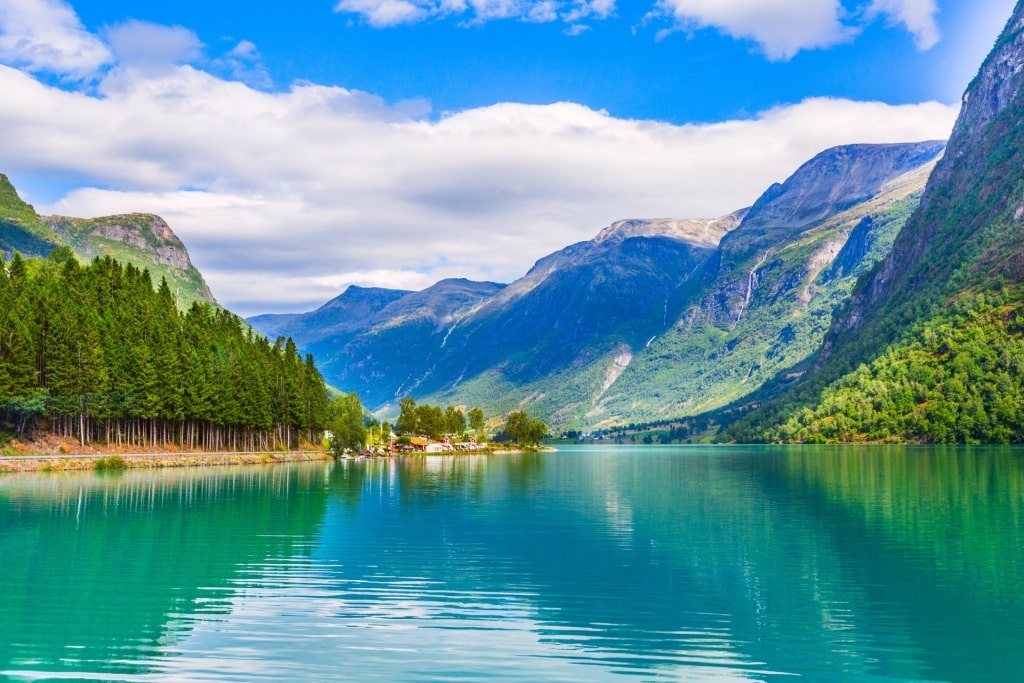
Nordfjord
Swimming, kayaking, and hiking, are all popular nature-led activities on the Nordfjord. Horseback riding is popular, too, with Nordfjord famous for its mild-mannered fjord horses, one of the world’s oldest horse breeds.
These beautiful creatures range from creamy coffee color to bronze and graze on the wildflowers and grass around the fjord. Equestrian experiences, including horseback riding and meeting the horses, are offered at the Norwegian Fjord Horse Center in Nordfjordeid.
Romsdalsfjord
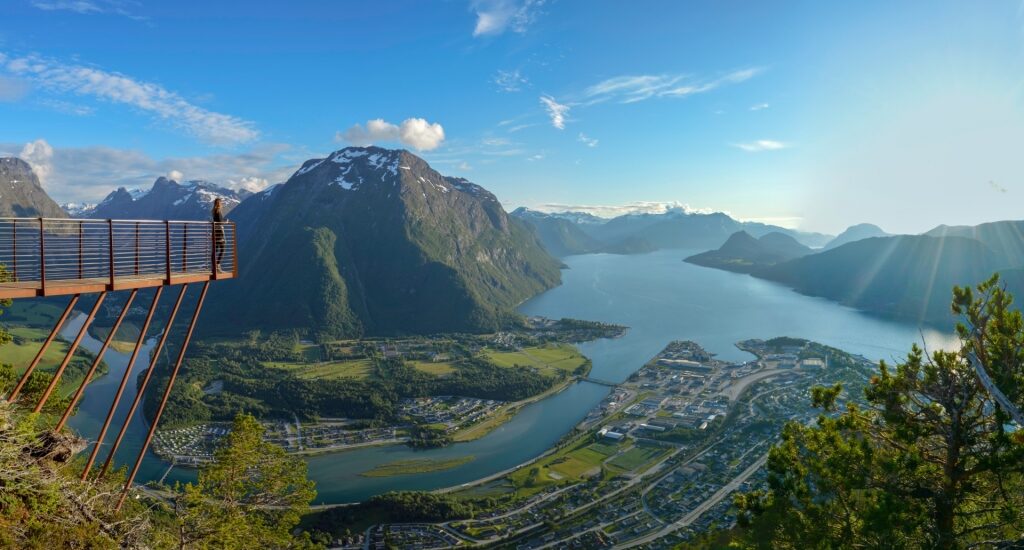
Romsdalsfjord
Picturesque Romsdalsfjord lies south of Molde in western Norway, with several outlying islands separating the fjord from the Atlantic Ocean.
The 55-mile-long fjord features the town of Åndalsnes in the Romsdalen Valley on its south shore, and the village of Isfjorden at its innermost tip—both boasting a delicious alpine backdrop.
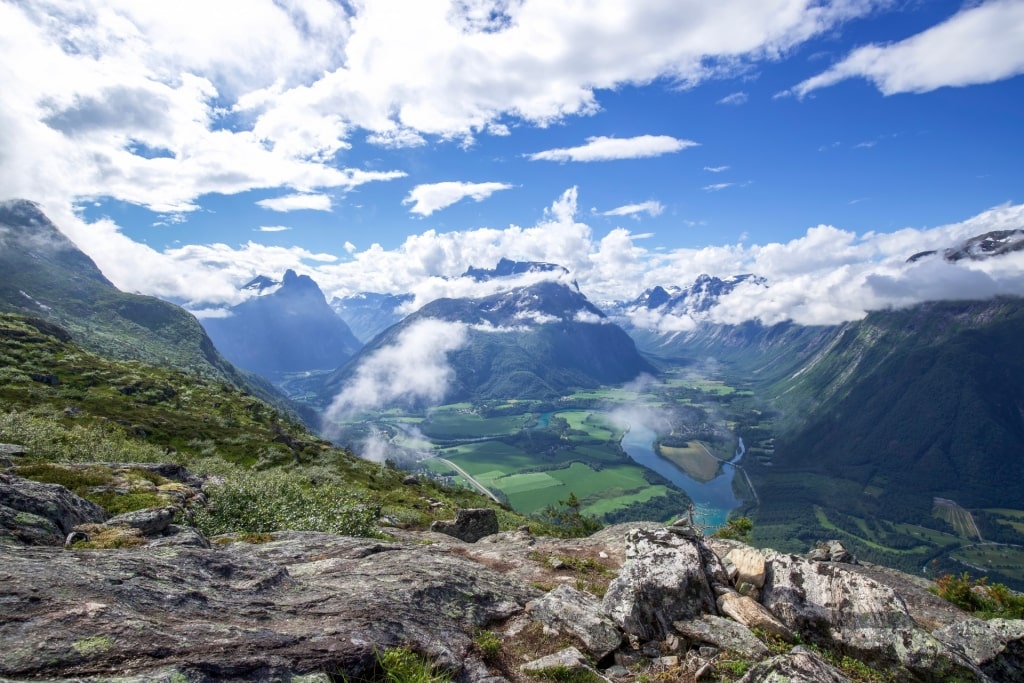
Mount Nesaksla
To get a bird’s-eye view of Romsdalsfjord, consider a hike to the top of Mount Nesaksla, rising 2,328 feet above Åndalsnes. Sections are fairly steep, though overall it’s a moderate-level hike. Notice the handiwork of Nepalese sherpas, who constructed the stone steps where the trail steepens.
A popular lookout point on Mount Nesaksla is Rampestreken. At 1,762 feet above sea level, the panoramas stretch across the fjord, into the valley, and over mountains. If you plan to tackle Nesaksla, carry plenty of water and wear hiking boots. You’ll want to set aside around three hours for the full hike.
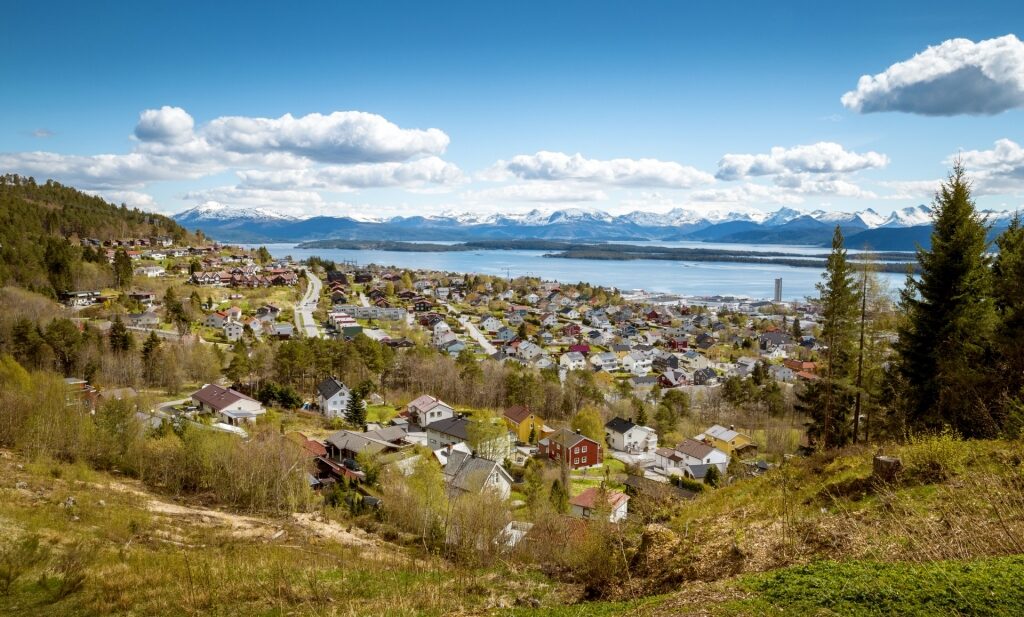
Molde
The Medieval city of Molde, lying on the Moldefjord, a limb of the Romsdalsfjord, has an immaculate harbor from where ferries dart across the fjord to Vestnes and Sekken island.
If you opt to spend time in Molde, visit the open-air Romsdal museum to explore the town’s centuries of history. Wander down Bygata, the main street of the museum, featuring traditional Nordic houses.
Sognefjord
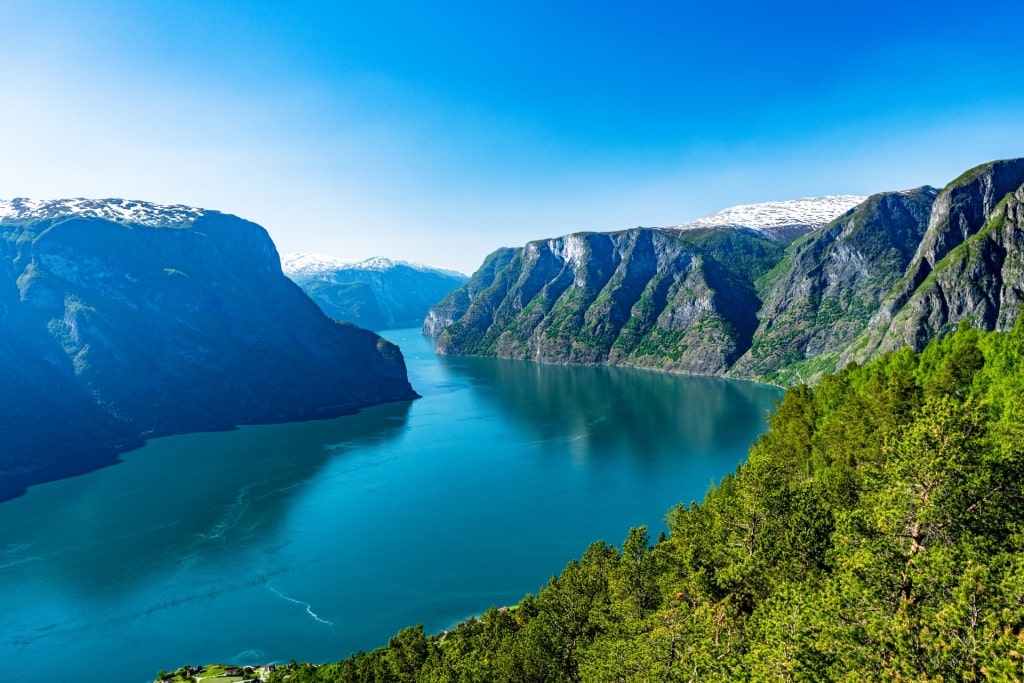
Sognefjord
The longest and deepest fjord in Norway is the snaking Sognefjord, lying midway between Måløy and Bergen on the west coast.
The Sognefjord winds a whopping 127 miles inland—with several offshoots, including the Nærøyfjord, Lustrafjorden, and Aurlandsfjord—to its furthest reaches in Skjolden.
The tricky-to-pronounce Fjærlandsfjord is a northern branch of the Sognefjord, where the water shimmers emerald green, reflecting the wild forests that surround it.
There’s a ferry service connecting the two sides of Fjærlandsfjord, from Vangsnes to Dragsvik and Hella at the entrance to the Fjærlandsfjord. The crossing takes around 15 minutes and operates year-round.
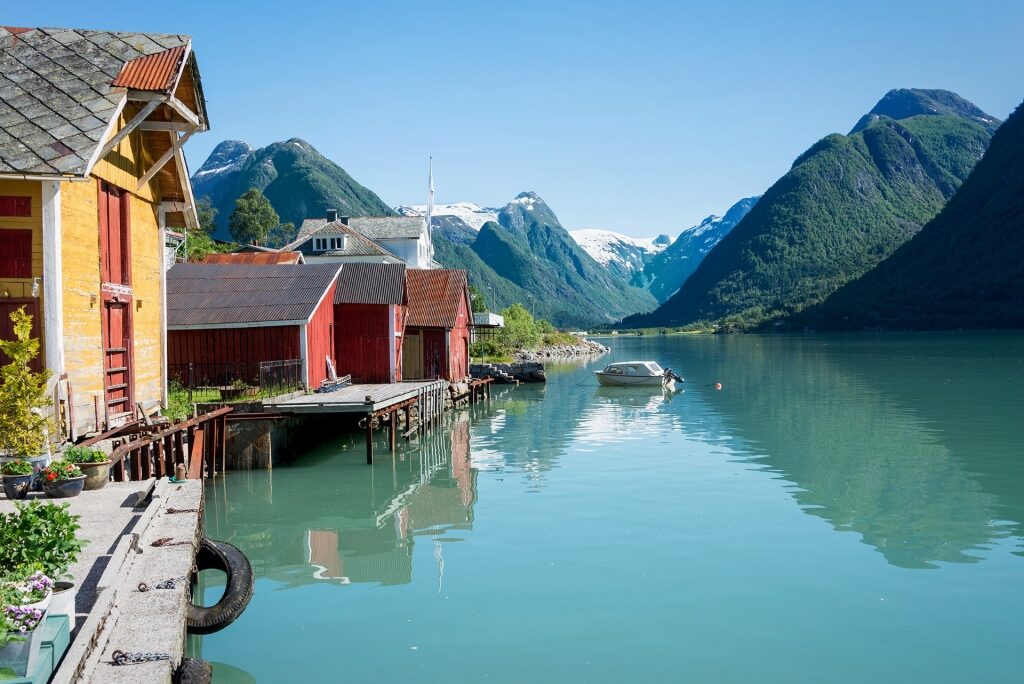
Mundal
Tucked into the Fjærlandsfjord, on the fjord’s west shore, is the little village of Mundal. It consists of no more than a couple of houses and guest lodges, but it makes for an attractive stopping point on either a boat or road trip around the Sognefjord.
Between May and September is the best time to visit, when guided kayak tours depart from Mundal, providing views of the nearby Bøyabreen and Flatbreen glaciers.
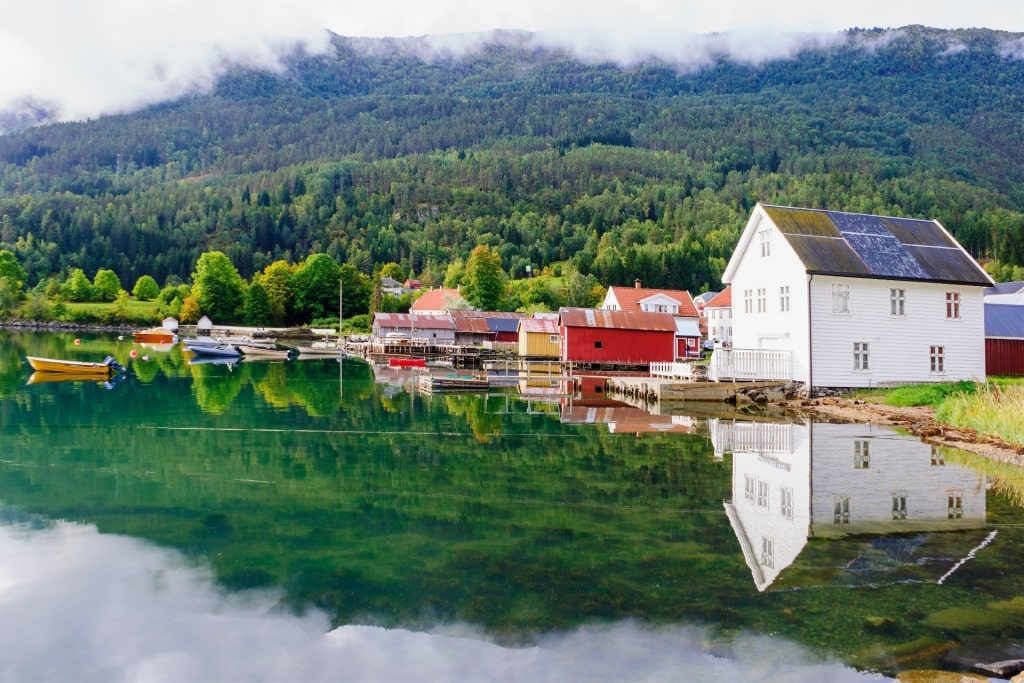
Solvorn
Solvorn, on the Lustrafjord arm of the Sognefjord, is another gorgeous spot with a picturebook harbor of white wooden houses hemmed in by picket fences.
There are a couple of cafés serving ice cream, cake, coffee, and other sweet and savory treats. Solvorn faces Urnes, with a 30-minute ferry service connecting the two villages during summer.
The 12th-century Urnes Stave Church is UNESCO-protected as one of the oldest stave churches in Norway. Explore the church’s fairytale-like architecture to see carvings on the north portal that predate the existing church.
Hjørundfjorden
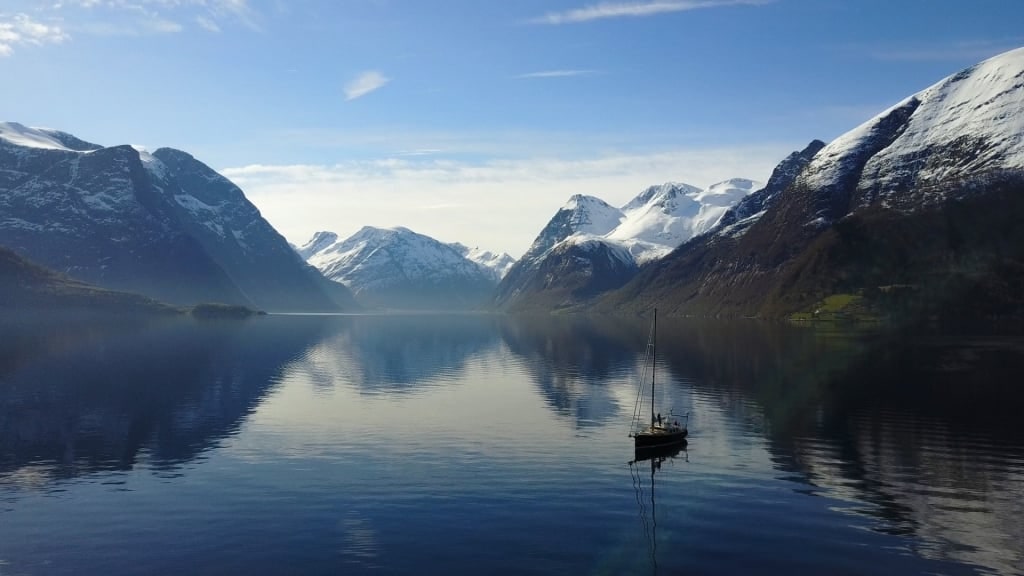
Hjørundfjorden
The majestic Hjørundfjorden lies south-southeast of Ålesund, branching off the sprawling Storfjorden. The sawtoothed Sunnmørsalpane mountains surround Hjørundfjorden, with peaks as tall as 5,600 feet rising up from the fjord.
One of the best ways to experience Hjørundfjorden is by boat from Solevagen, just south of Ålesund. Gaze at the beautiful mountain scenery as you sail along the 22-mile-long fjord before returning to Ålesund, famed for its art nouveau architecture.
Due to Hjørundfjorden’s steep landscape, there are very few villages on the fjord. This adds to Hjørundfjorden’s blissfully remote feel.
Oslofjord
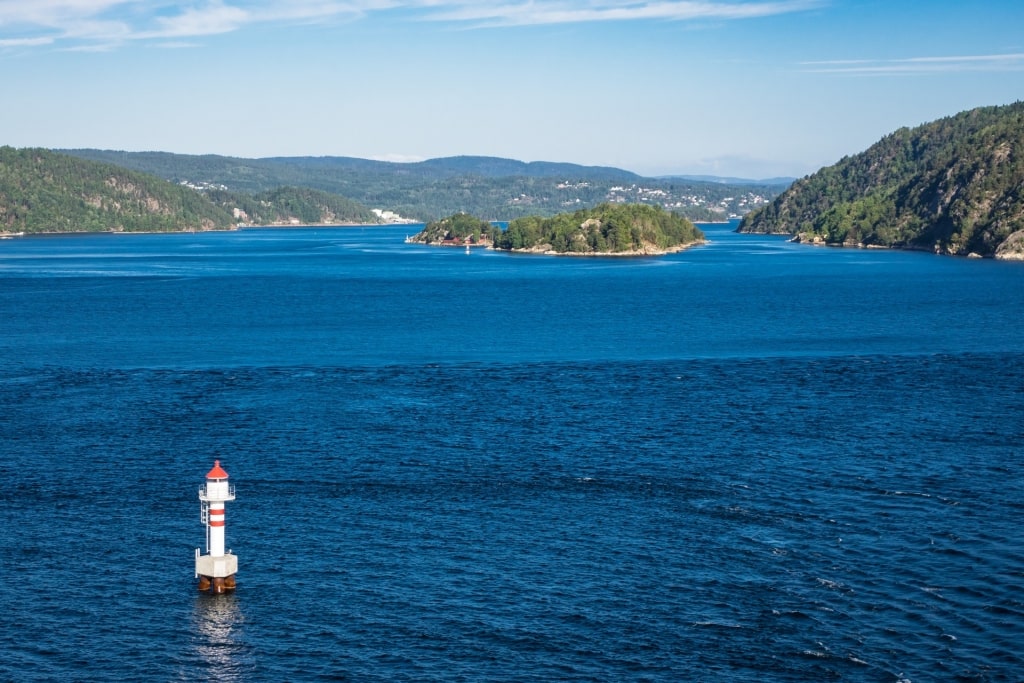
Oslofjord
While Norway is synonymous with fjords, the country’s capital city, Oslo, is more well-known for its fabulous museums and cosmopolitan restaurants, despite lying at the end of the Oslofjord.
The 62-mile-long fjord is dotted with idyllic islands and nature reserves. Oslo Ferries operate a service from Rådhusbrygga (the City Hall pier) to several of the inner fjord islands, including Hovedøya, Lindøya, and Nakholmen. Spend the day island-hopping to enjoy nature walks, beaches, and a fjord-side picnic.
Visitors don’t have to take the ferry to enjoy the Oslofjord, though. If you’re a fan of sea swimming, head for Sørenga Seawater Pool, with a beach, a children’s pool, and a diving platform.
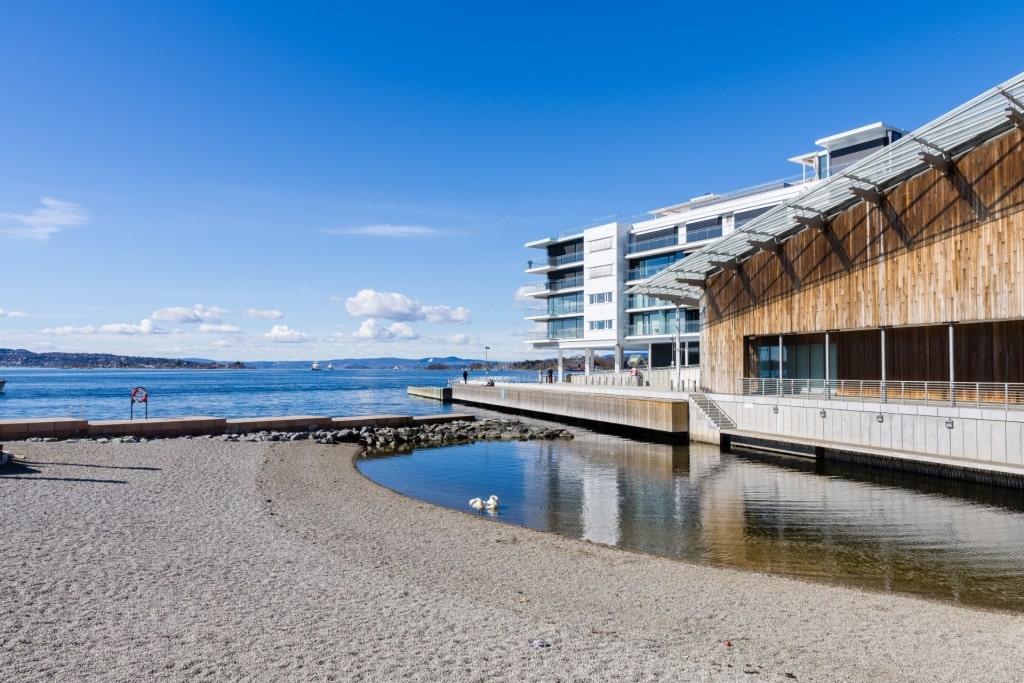
Astrup Fearnley Museum of Modern Art, Oslo
Right next to Oslo’s Astrup Fearnley Museum of Modern Art is the popular Tjuvholmen City Beach, one of the best beaches in Norway. Kayaking is popular, too, with regular tours departing from the nearby Sjølyst Marina.
One of the many great things about Oslo is the city’s walkability. Travelers can easily explore on foot, covering many of Oslo’s museums, including The National Museum and Munch, on the waterfront, while soaking up soothing fjord views.
Top Activities in the Norwegian Fjords
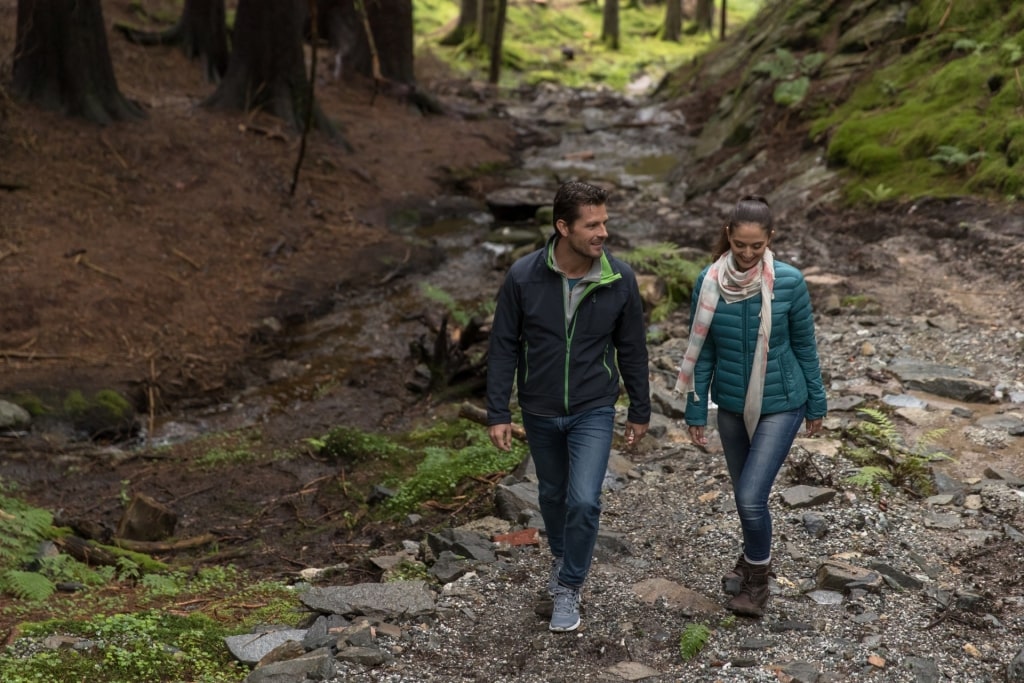
Hiking in Norway
The Norwegian fjords is a dream destination for active travelers and lovers of outdoor pursuits. With an abundance of mountains, meadows, woodlands, and waterfalls, the top activity here is hiking, with trails lacing Norway’s coast and countryside.
Ålesund’s Sukkertoppen, which translates as Sugar Top, offers sublime 360-degree views from its summit. Sukkertoppen is walkable from the center of Ålesund by following the trail signs, which first take hikers via a gravel path, then a wooded area to the top. The route takes roughly three hours round-trip, but you’ll want to allow extra time to soak in the views.
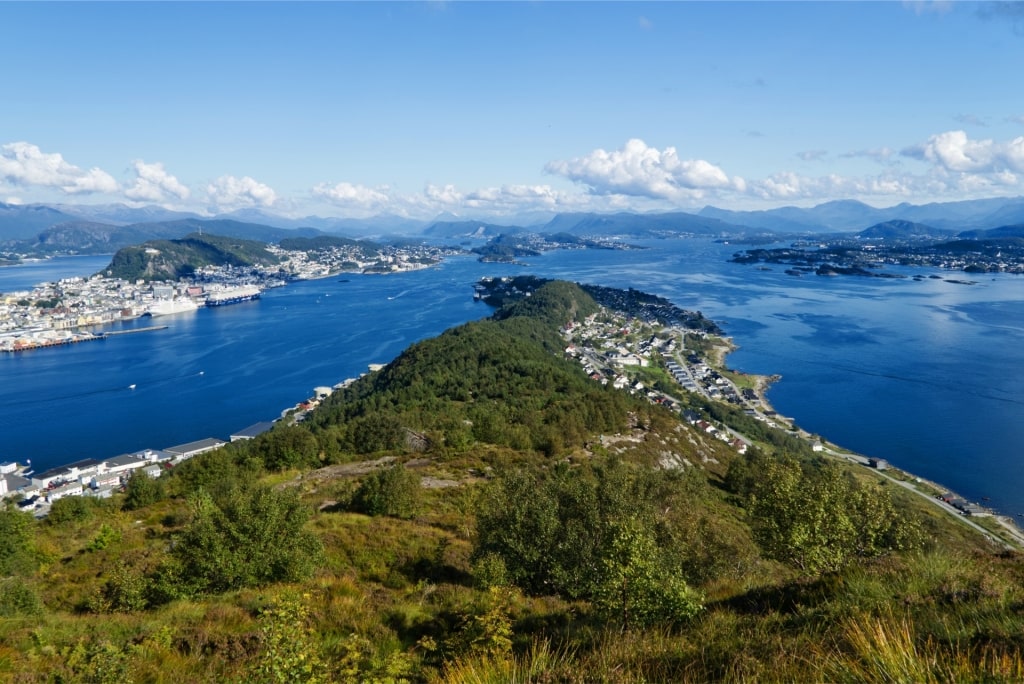
Sukkertoppen, Alesund
Get a bird’s eye view of gorgeous Bergen and the surrounding fjords by climbing one of the seven mountains around the city, such as Mount Løvstakken. Mount Løvstakken’s trail begins from near supermarket Matkroken, with the gentle route taking around 15-20 minutes.
Biking and kayaking are hugely popular in Norway’s fjords with rental companies and guided tours offered from most fjord towns and cities, from Trondheim’s harbor in the north to Oslo’s waterfront in the south.
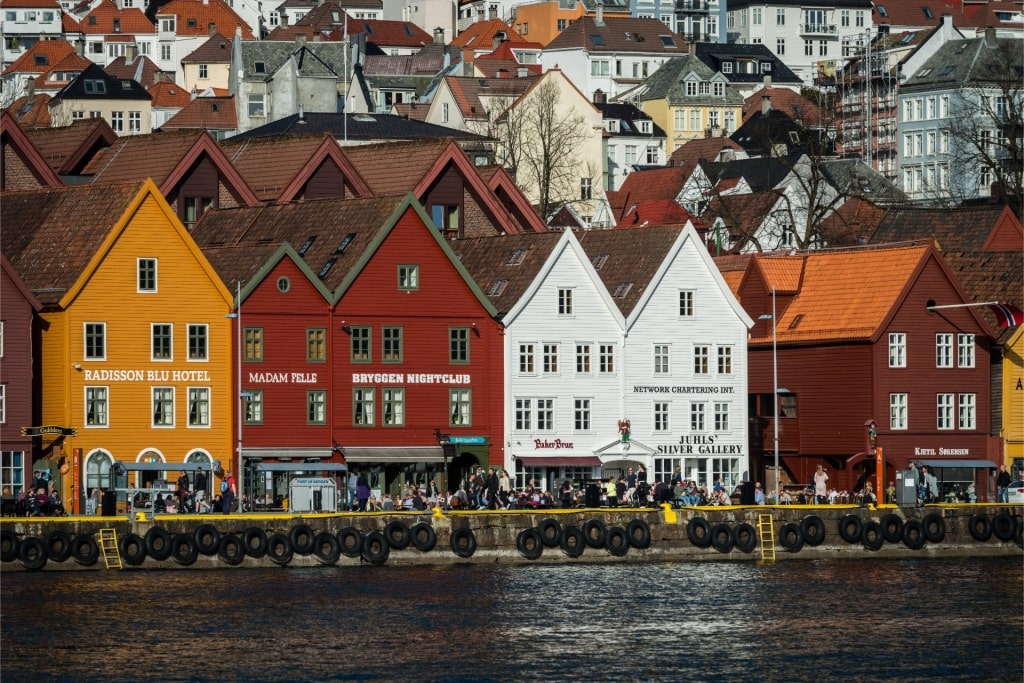
Bryggen, Bergen
If you’re keen to dig into local culture and history, Norway’s fjords have a raft of outstanding museums to explore, too.
Among the top things to do in Bergen is visiting the fantastic Maritime Museum and the Bryggens Museum, located within the UNESCO-listed historic Bryggen neighborhood, which reveals the city’s archaeological finds.
In Stavanger, the Norwegian Petroleum Museum delves into the city’s powerhouse status as Norway’s capital of oil, while the Norwegian Canning Museum features exhibitions and demonstrations set in a former canning factory.
Best Time to Visit

Geiranger
The best time to visit fjords in Norway is during summertime, between June and August. During this period, Norway experiences extended hours of daylight, including the midnight sun in June, when the sun barely sets and it’s possible to hike, swim, and kayak late into the night.
The further north you travel in Norway, the longer the hours of daylight during summertime. Temperatures can vary up and down Norway, with this long and slim country stretching from the Arctic Circle in the far north to Kristiansand on the Topdalsfjorden in the south.
If you’re exploring the Oslofjord, from the capital, the average summer temperature is around 64.5°F, or 18°C, though it can get much hotter, reaching into the 80s.
Weather along the western strip of Norway, the region most people associate with Norway’s fjords, can be misty, even during summertime, with rain showers common, too.
Travel Tips

Hiking in Norway
Mosquitos are not uncommon in the Norwegian fjords so pack bug spray and soothing aloe vera in case you get bitten.
Pack layers for exploring the fjords in Norway. T-shirts, sweaters, athleisure wear, leggings, cargo pants, and even shorts, with sturdy, comfortable hiking boots are a good shout. Pack a sun hat, sunglasses, and sunblock for the ample time you’ll spend outdoors.
It’s worth investing in a good quality camera or upgrading your cell phone to ensure you can capture the fjords’ spectacular beauty.
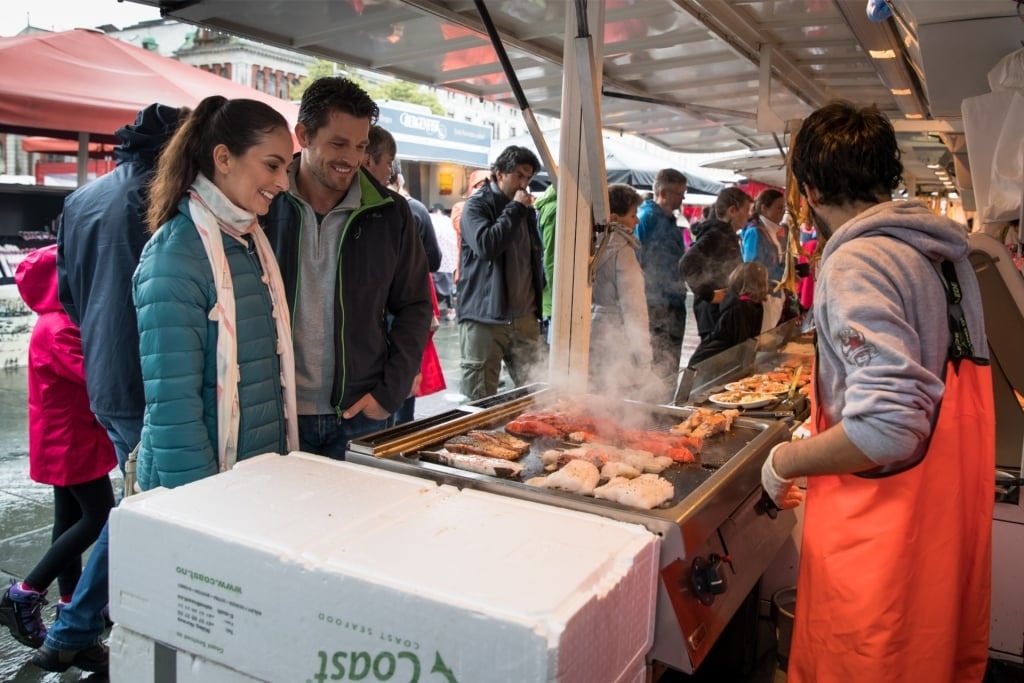
Bergen Fish Market
Indulge in Norway’s delicious and ultra-fresh seafood. Crab, mussels, cod, salmon smoked salmon, and canned sardines are all popular and widely available. In Bergen, visit the historic Fish Market, right on the waterfront, to sample these local delicacies, including oysters, caviar, and freshly made sushi.
Before you settle in for a seafood lunch, take Bergen’s light railway to visit Fantoft Stave Church, with the journey taking roughly 35 minutes. Originally built in 1170, this fairytale-like church was moved to Fantoft in 1883. The existing building is essentially a replica of the original, which burned to the ground during a suspected arson attack in 1992.
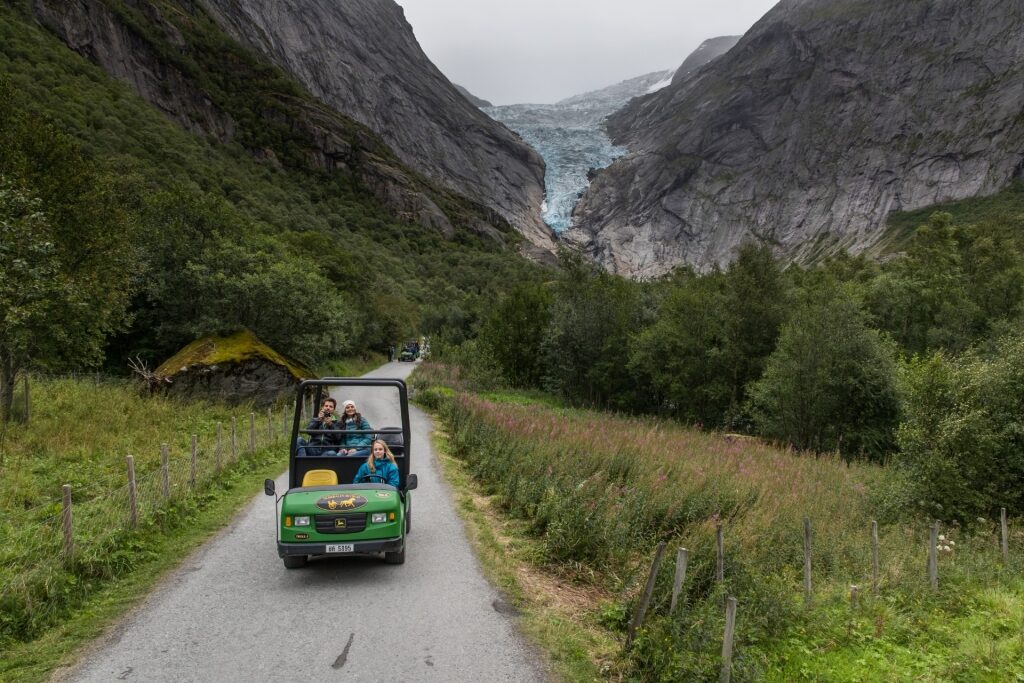
Briksdal Glacier
While the fjords in Norway are popular for active travelers, if you’re less mobile or simply prefer a more leisurely way to explore this beautiful country, there are options such as the scenic Flam Railway, which takes in the magnificent Kjosfossen, one of Norway’s beautiful waterfalls. Or you could opt for the trolley car to see the magnificent Briksdal Glacier near Olden.
Frequently Asked Questions About the Norwegian Fjords
What's the best way to see the Norwegian fjords?

Lysefjord
The best way to see the Norwegian fjords is by boat. For example, you could explore one of the most famous fjords in Norway when visiting destinations such as Oslo, Bergen, Stavanger, and Tromso.
The town of Molde lies on the Fannefjorden, Trondheim on the Trondheimsfjorden, and Nordfjordeid on the Eidsfjorden. You’ll find regular scenic fjord ferry and boat trips operating from these destinations.
If you’re more of an active traveler, hiking, kayaking, and biking are all great options to see the fjords in Norway.
What is the best month to visit the fjords?
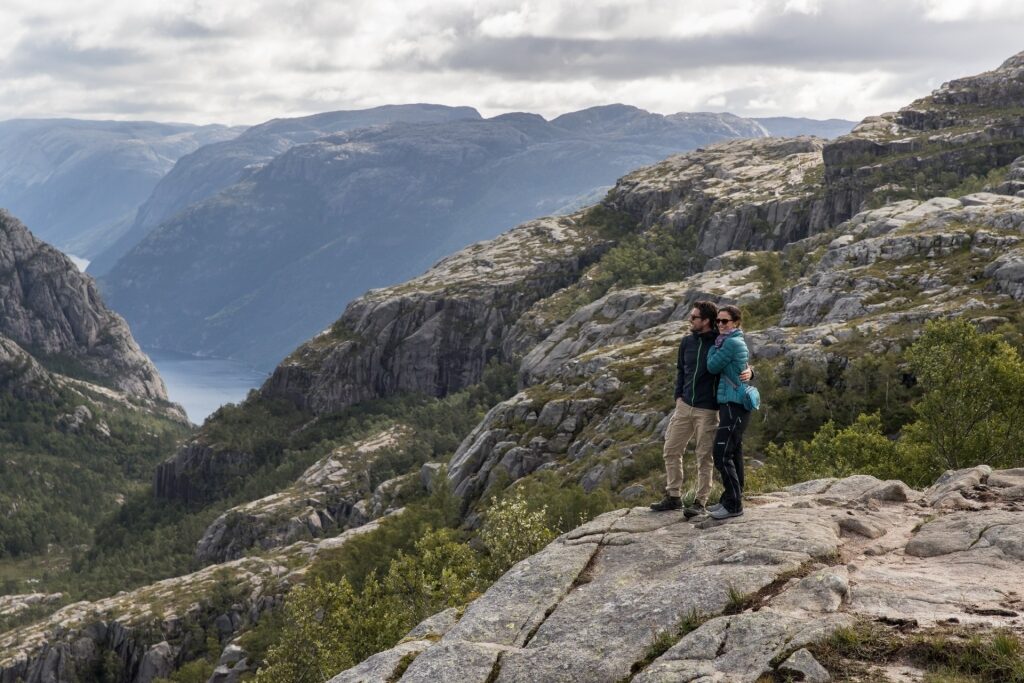
Pulpit Rock
To embrace the plethora of outdoor activities that the fjords in Norway presents, June, July, and August are the best months to visit. During this period, you can expect longer hours of daylight and generally mild weather.
How long should you spend in the fjords?
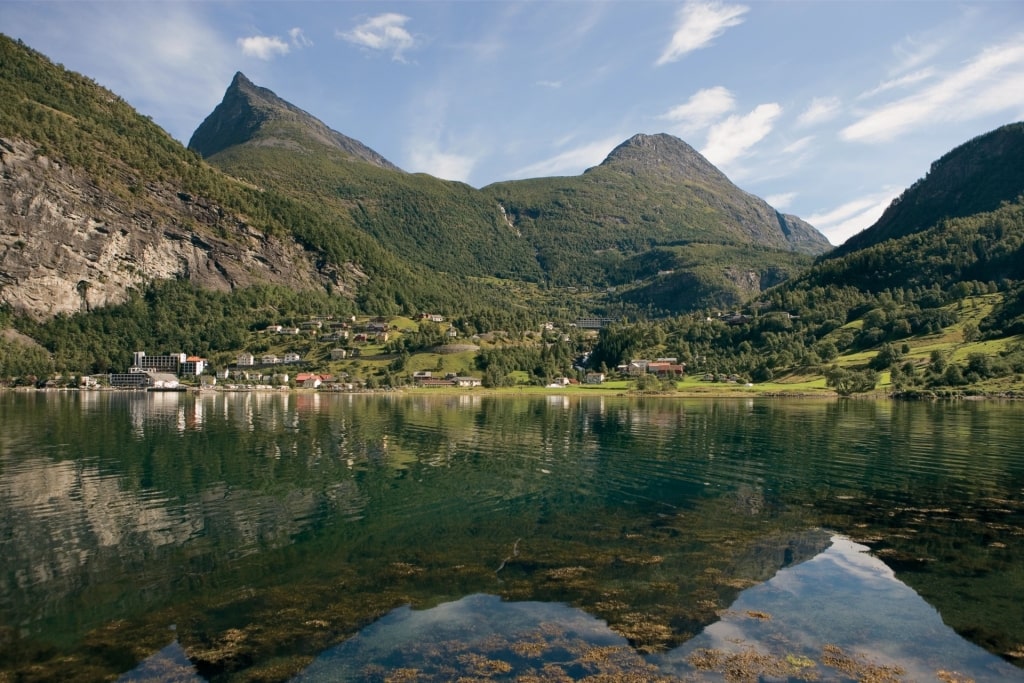
Geirangerfjord
You could spend seven nights here and take in a couple of the Norwegian fjords, say, the Aurlandsfjord and the Geirangerfjord.
If you would like to travel further, perhaps exploring the fjords and heading north into the Arctic Circle, 12 to 14 nights is the ideal length of time you will want to spend here to give you the opportunity to explore several famous fjords in Norway on a single trip.
What wildlife can you see in the fjords?
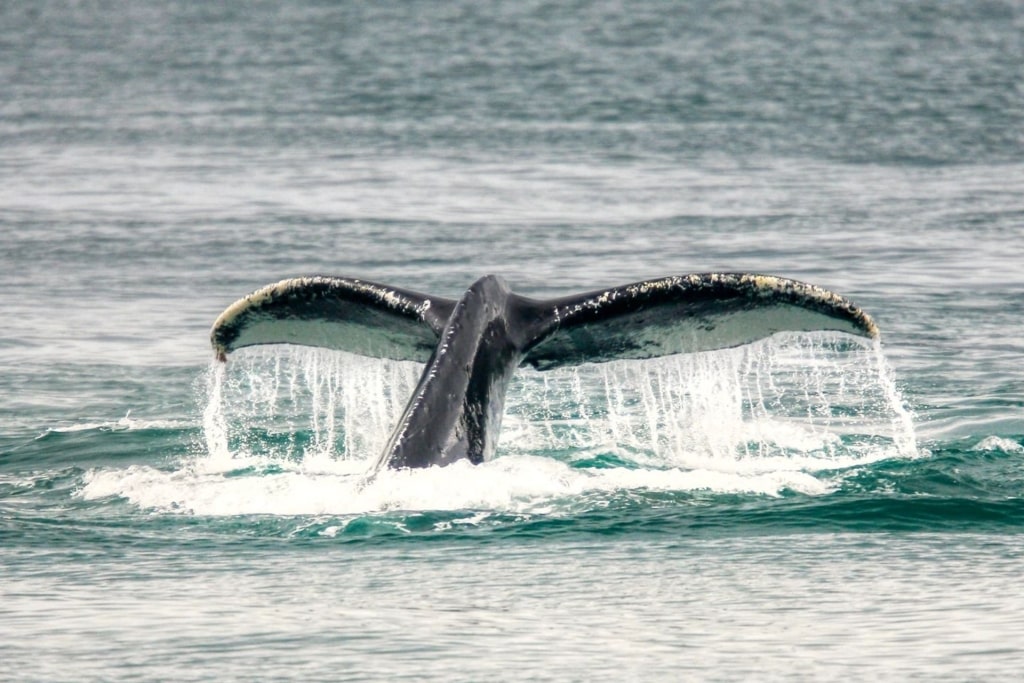
Humpback whale
From bird to marine life and creatures of the land, the Norwegian fjords are rich in wildlife. Fish inhabit the west coast’s waters, including cod, salmon, and coalfish. The further north you go on Norway’s west coast, the greater the chance of seeing whales, including humpback, sperm, minke, and fin. Seals and harbor porpoises can also be spotted on the coastline.
The fjords in Norway are a bird watcher’s paradise with the rugged coastline and grassy cliffs home to adorable Atlantic puffins and majestic white-tailed eagles, the largest bird of prey found in Norway. Norway is home to around 300 resident bird species and a further 200 migrating species.
Rundebranden, an island near Ålesund, thrives with birdlife. There are trails up and around the mountain offering the chance to view northern gannets, common guillemots, razorbills, kittiwakes, and Atlantic puffins during summertime.
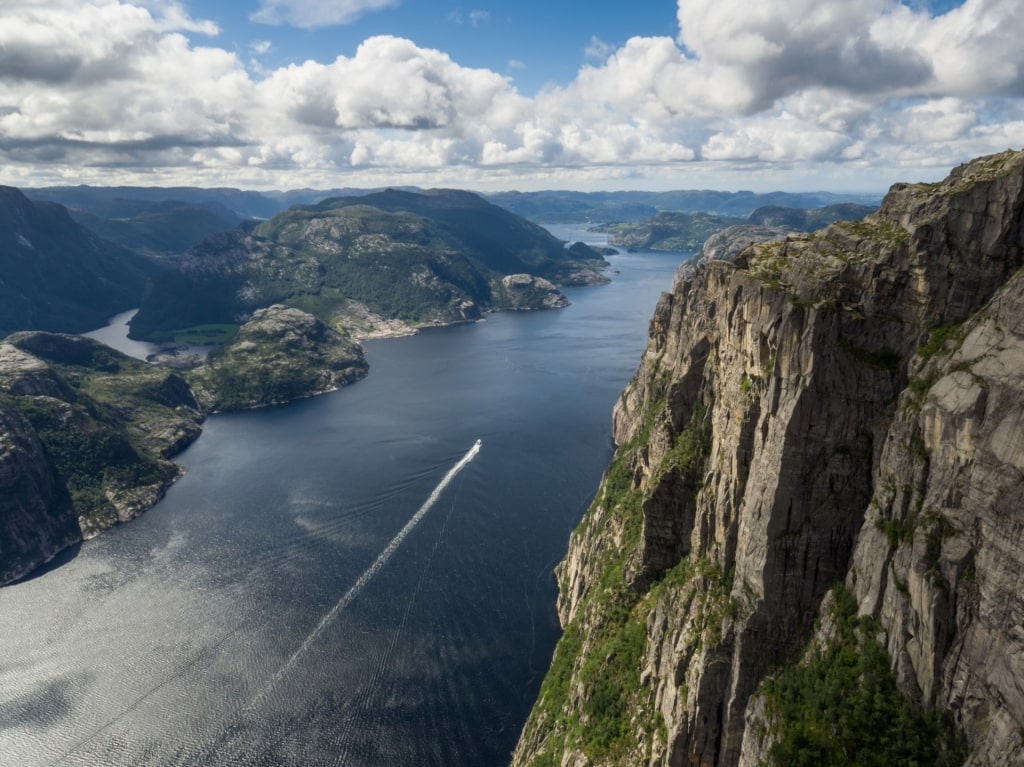
Lysefjord
Discover the beauty of the fjords for yourself. Browse Celebrity’s cruises to Norway and plan your summer adventure.


